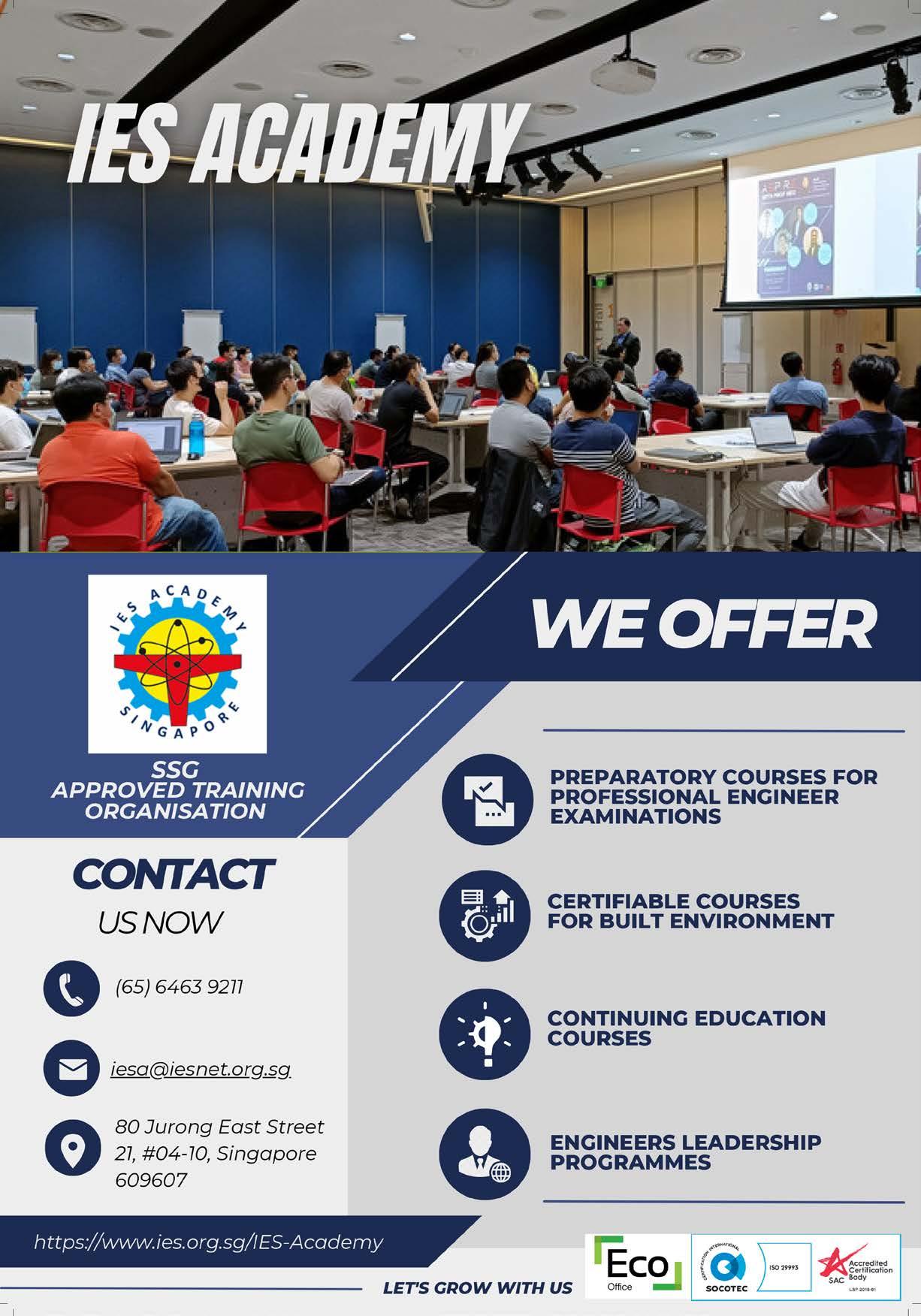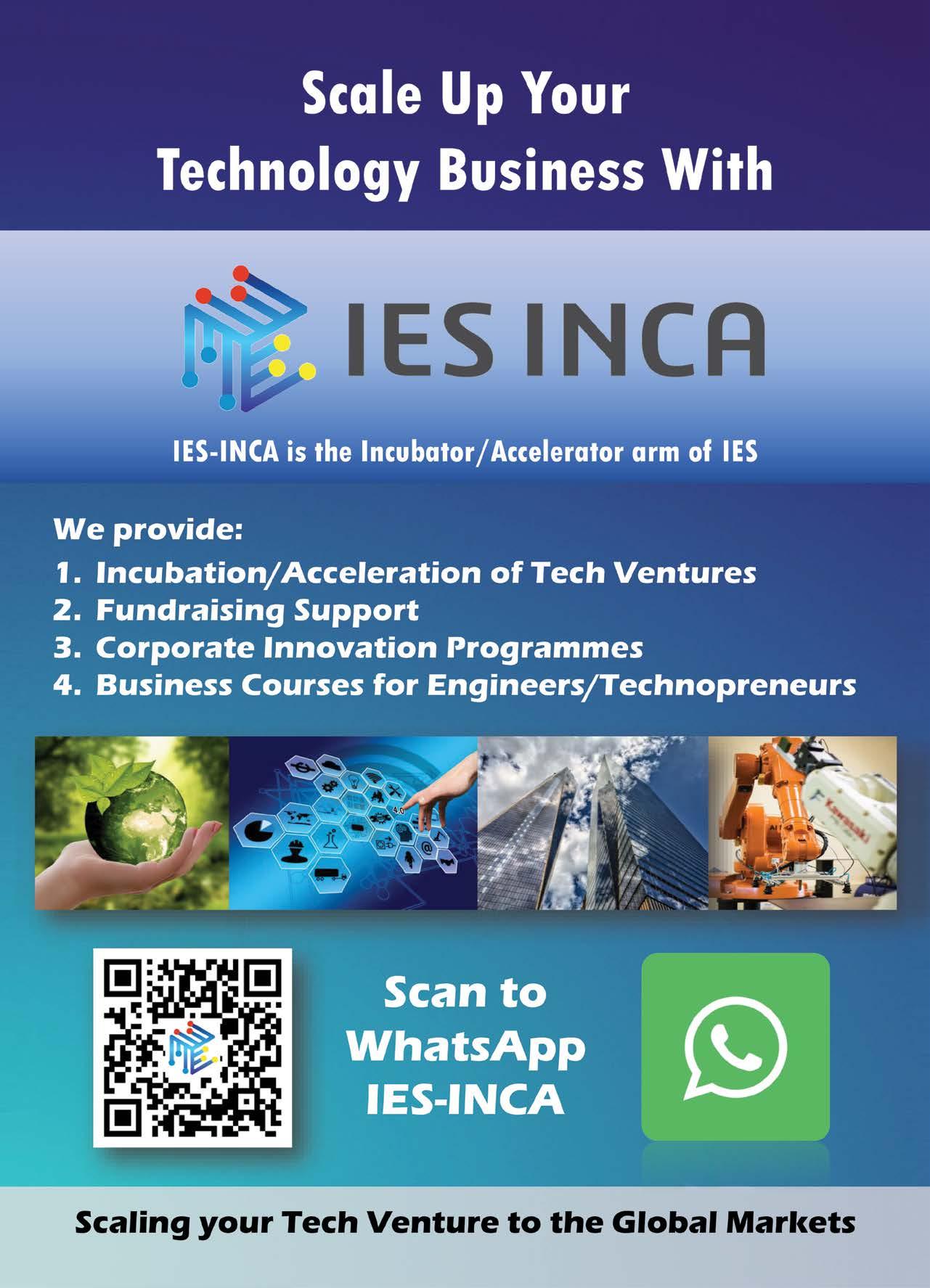
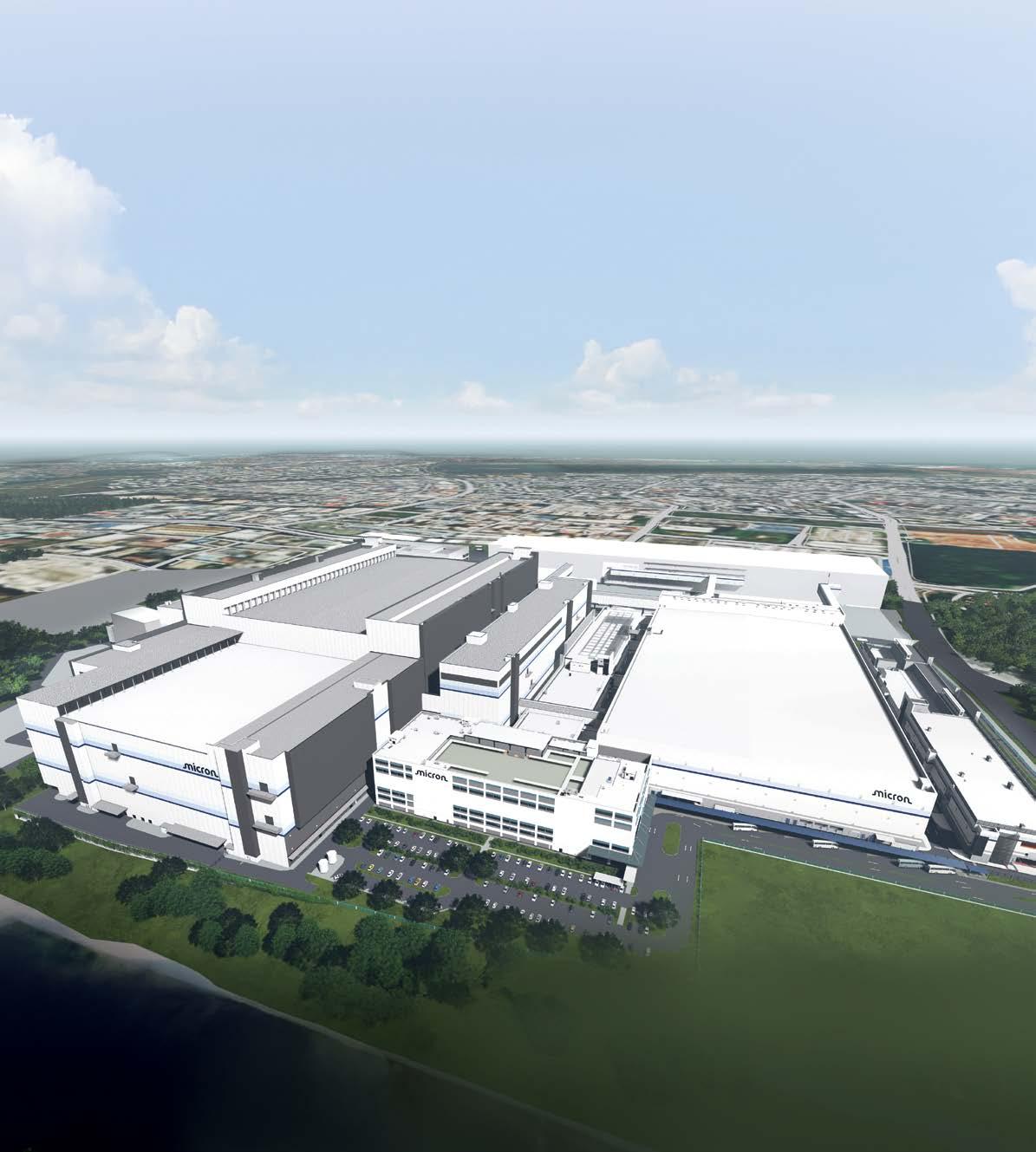



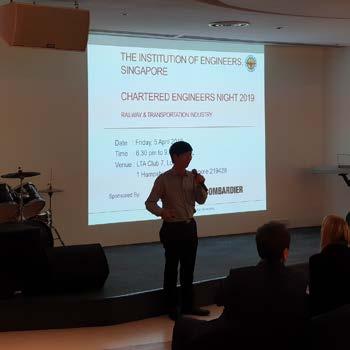
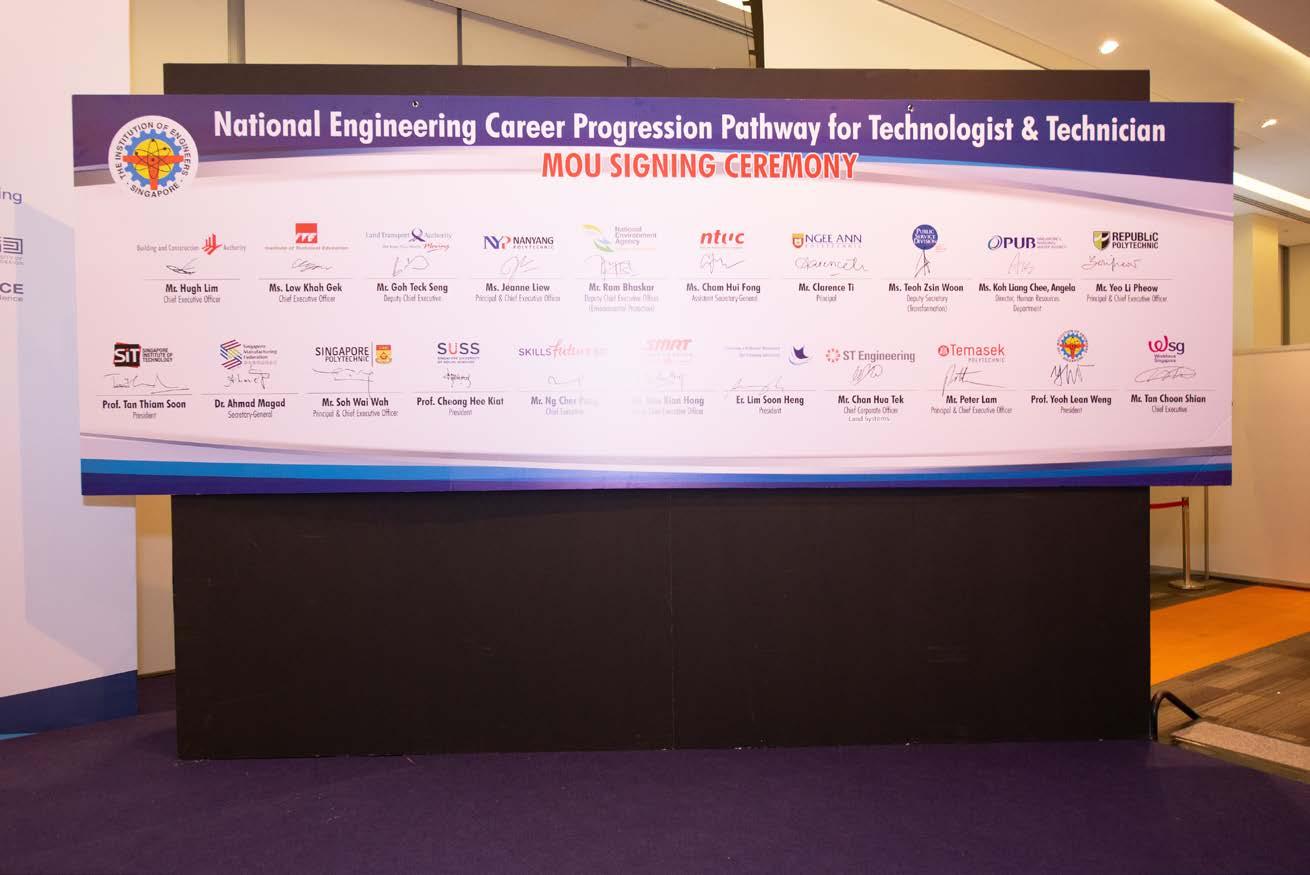

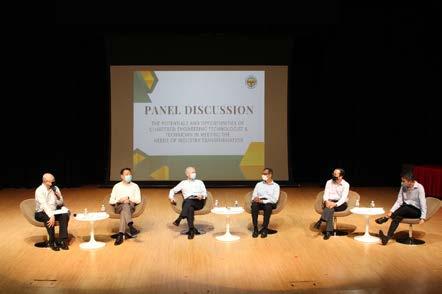
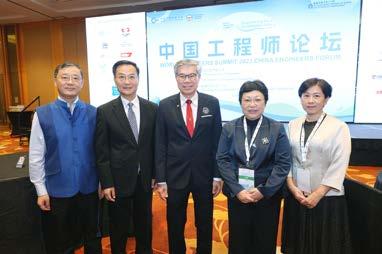











The Chartered Engineering Registry aims to provide professional recognition to qualified Engineers, Technologists and Technicians across all sectors.
Being registered as a Chartered Engineering Professional will be an external validation of your experience, expertise and practising competence; and is a quality mark to differentiate your professional standing in the following sectors of engineering:




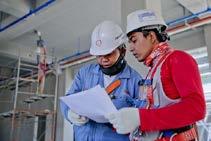






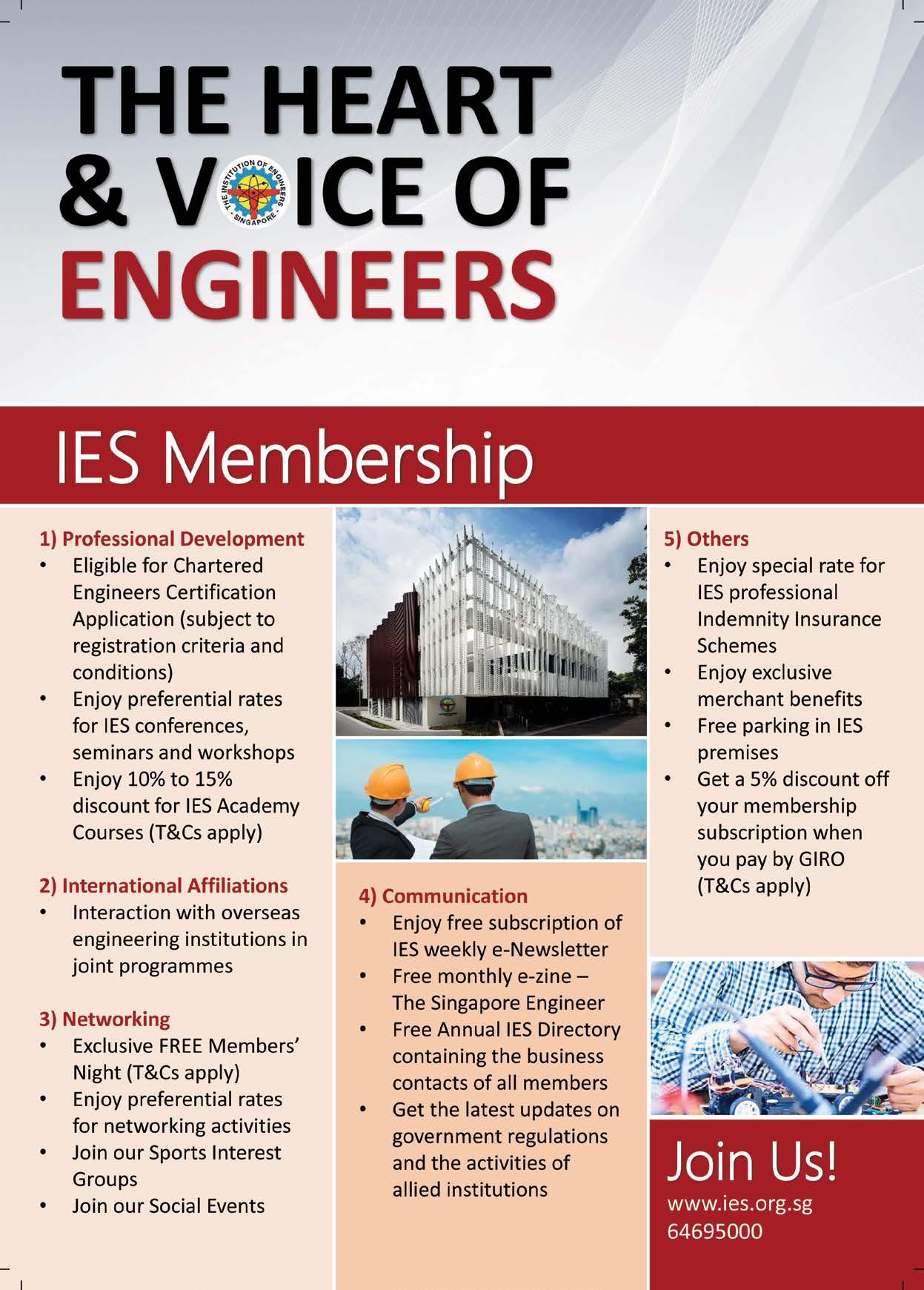
06 Lee Kuan Yew Water Prize 2026 opens for nominations
07 Schneider Electric and CPG Corporation sign MoU to accelerate decarbonisation
08 Advancing built environment education and sustainability initiatives
09 Brightening 770 homes in Toa Payoh with energy-efficient lighting
10 NTU Singapore and Trinasolar to advance AI-powered smart energy storage solutions
11 CSA Group expands testing capabilities with new facility in Singapore
12 Leng Aik Engineering launches Advanced DfMA factory for prefab MEP systems
13 Funding the Asia Pacific data centre pipeline Environmental impact of the global data centre market
COVER STORY
14 New High Bandwidth Memory advanced packaging facility to be set up in Singapore SPECIAL FOCUS: ENGINEERING EDUCATION
16 Building sustainability through knowledge SPECIAL FOCUS: HVAC
18 AHR Expo 2025 features an abundance of innovation
19 Survey reveals hybrid cloud and AI integration as key drivers for IT innovation in 2025
20 Unlocking the power of digital transformation for manufacturers
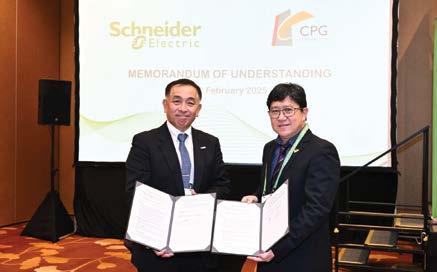
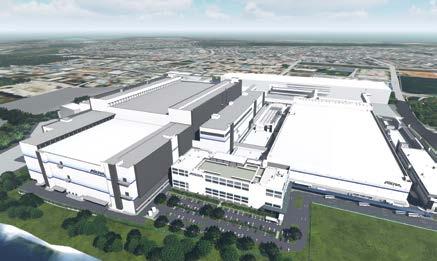

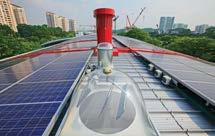


President Er. Chan Ewe Jin
Chief Editor T Bhaskaran t_b_n8@yahoo.com
Publications Manager Desmond Teo desmond@iesnet.org.sg
Editorial Panel
Dr Victor Sim
Dr Chandra Segaran
Dr Ang Keng Been
Dr Aaron Sham
Mr Jaime Vega Bautista Jr
Mr Soon Ren Jun Media Representative Trevor Teh


22 How digital tooling enhances operator safety in machining
24 The power of sound waves for stable cleanliness
26 The role of artificial intelligence in ship condition monitoring
27 Why IoT incidents hit harder than IT breaches
30 Report reveals shift towards software-driven solutions and AI
31 Ensuring consistent and efficient water flow at Financial Park Labuan
32 Fully electric commuter ferries contribute to maritime decarbonisation
33 Siemens expands Teamcenter X to make PLM accessible to companies of all sizes
34 Keysight unveils architecture for scaling data centres
35 Fortinet expands FortiAI across its security fabric platform
38 Providing visibility over critical infrastructure New edge amplifier for production applications
39 Low-profile AC-DC power supplies from XP Power
40 Xnergy develops wireless charging for smaller applications
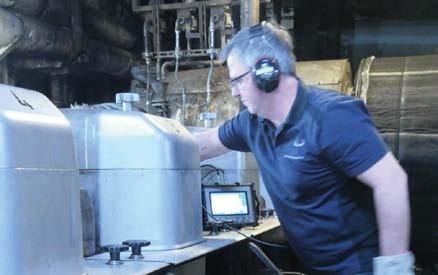
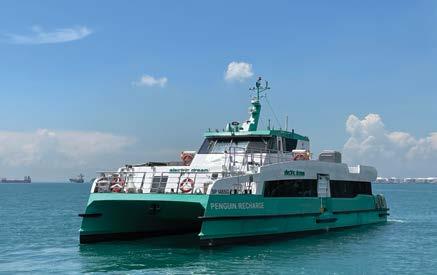
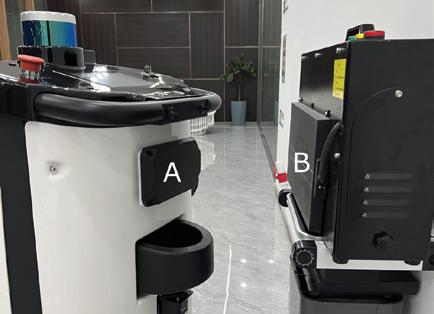
The Singapore Engineer is published monthly by The Institution of Engineers, Singapore (IES). The publication is distributed free-of-charge to IES members and affiliates. Views expressed in this publication do not necessarily reflect those of the Editor or IES. All rights reserved. No part of this magazine shall be reproduced, mechanically or electronically, without the prior consent of IES. Whilst every care is taken to ensure accuracy of the content at press time, IES will not be liable for any discrepancies. Unsolicited contributions are welcome but their inclusion in the magazine is at the discretion of the Editor.
The Hi-Flo Next Generation bag filters have been developed with performance and sustainability in mind. Performance means long service life, low energy consumption and stable filtration efficiency throughout its lifetime.

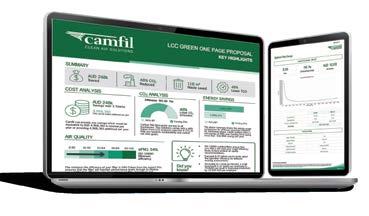
Extended operating life with the best Total Cost of Ownership (TCO)
Lowest energy consumption and initial pressure drop
Reduced energy consumption
12% vs old Hi-Flo generation 30% vs industry average
Superior indoor air quality
Particle efficiency meets requirements according to the European Standard EN779 and ISO16890 for indoor air quality (IAQ)
Reduced labour cost
25-50% Longer filter lifetime, compared to synthetic bag filters
Improved air flow
Conical and tapered pocket shape allows better airflow through the filter
Optimised design for high performance Fully incinerable with the plastic frame
Using Camfil Life Cycle Cost (LCC) Analysis software, our experts conduct a comparative analysis of different air filters to provide you with a comprehensive report on potential savings.
Camfil offers a complimentary Life Cycle Cost analysis and supports you in selecting the right air filter solution.
SCAN THE QR CODE to complete the survey. Accuracy is subject to information provided.

Lee Kuan Yew Water Prize (LKYWP) 2026, the prestigious biennial award that honours outstanding contributions by individuals or organisations for solving the world’s water challenges, has launched its call for nominations.
The LKYWP is named after Singapore’s founding Prime Minister, Mr Lee Kuan Yew, whose vision and leadership enabled Singapore to overcome its challenges as a water-stressed city-state, to secure a resilient and sustainable water supply.
Since its inception in 2008, the Prize has gained a strong standing in the global water arena for its recognition of innovative water technologies, programmes and policies, that have been gamechangers in their real-world application.
The honour roll for the Prize includes Laureates who have developed ground-breaking solutions in wastewater-based epidemiology, membrane technology and used water treatment, as well as holistic water policies and management practices.
These solutions have benefitted the lives of millions. The achievements of the Laureates represent the pinnacle in water solutions that have made a difference to cities and people around the world.
Presented in partnership with Temasek Foundation, the LKYWP 2026 Laureate will be announced in April 2026. The Laureate will receive SGD 300,000, a gold medallion and a certificate, at the Prize banquet and award ceremony, during the 11th Singapore International Water Week, which will be held from 15 to 19 June 2026.
Nomination process
Leaders of international water companies and water utilities, top academics in water research,
policy and/or management, heads of international organisations, members of government, or distinguished individuals in the field of water are welcome to submit nominations of suitable candidates for the LKYWP 2026.
This can be done online by uploading a citation of the nominee’s achievements at https:// go.gov.sg/lkywp2026nomination.
Nominations for the LKYWP 2026 are open from 16 April 2025 to 11 July 2025.
Shortlisted nominees will be notified to submit supporting documents for a more detailed evaluation by the Water Prize Nominating Committee. The Nominating Committee will thoroughly evaluate all shortlisted nominations and make their recommendations to the Water Prize Council, who will then decide on the LKYWP 2026 Laureate.
For more information, visit https://www.siww.com.sg/landingpage/nomination-guidelines or email leekuanyewwaterprize@siww. com.sg.
Singapore International Water Week (SIWW) is one of the world’s premier platforms to share and co-create innovative water, coastal protection and flood solutions, to meet urban water and associated climate challenges.
Organised by Singapore International Water Week Pte Ltd, a subsidiary of PUB, Singapore's National Water Agency, the biennial SIWW delivers a range of flagship programmes and platforms that gather stakeholders from governments, cities, utilities, academia and industry, to share best practices and solutions, showcase the latest technologies and harness business opportunities.
Year Laureate
2024 Prof Gertjan Medema
2020 Prof Kazuo Yamamoto
2018 Prof Rita Colwell
2016 Prof John Anthony Cherry
2014 Orange County Water District
2012 Prof Mark van Loosdrecht
2011 Dr James Barnard
2010 Yellow River Conservancy Commission
2009 Prof Gatze Lettinga
2008 Dr Andrew Benedek
Lee Kuan Yew Water Prize Laureates (2008-2024).
PUB
PUB, Singapore’s National Water Agency, is a statutory board under the Ministry of Sustainability and the Environment (MSE). PUB manages Singapore's water supply, water catchment, and used water reclamation and reuse, in an integrated way.
From April 2020, PUB also took on the responsibility of protecting Singapore’s coastline from sealevel rise, as the national coastal protection agency.
Temasek Foundation
Temasek Foundation supports a diverse range of programmes that uplift lives and communities in Singapore and beyond. Temasek Foundation’s programmes are made possible through philanthropic endowments from Temasek, as well as gifts and other contributions from other donors.
Schneider Electric, a leader in the digital transformation of energy management and automation, recently announced a strategic partnership with CPG Corporation, a leading provider of integrated solutions for the built environment, to collaborate on the development of greening Singapore’s physical infrastructure.
To mark the beginning of the partnership, an MoU was signed by Mr Tan Shao Yen, President and Group CEO of CPG Corporation and Mr Yoon Young Kim, Cluster President of Schneider Electric Singapore and Brunei, at Schneider Electric’s 2025 Singapore Innovation Day,
As Schneider Electric’s flagship stakeholder event, Innovation Day fosters strategic partnerships and drives best practices in sustainability and digital transformation.
Aligned with ‘Scaling Up for a Net Zero Singapore’, the theme of this year’s Innovation Day, the collaboration highlights Schneider Electric’s expertise in sustainable digital energy management solutions and CPG’s extensive experience in sustainable green design as well as developing and delivering critical large-scale public and private infrastructure projects.
This partnership reflects the growing momentum for strategic collaborations in advancing decarbonisation and underscores the role of leading industry players in supporting Singapore’s sustainability ambitions, accelerating the development of energy-efficient, intelligent buildings that contribute to a greener, more resilient urban landscape.
As part of the MoU, Schneider Electric and CPG Corporation will collaborate to drive sustainability through new business opportunities. This includes cross-support on tenders and carbon advisory services,
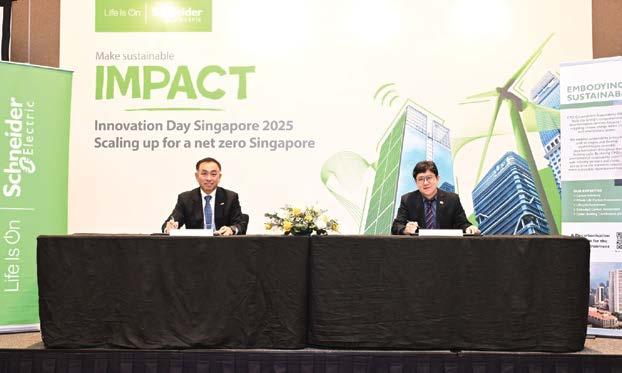
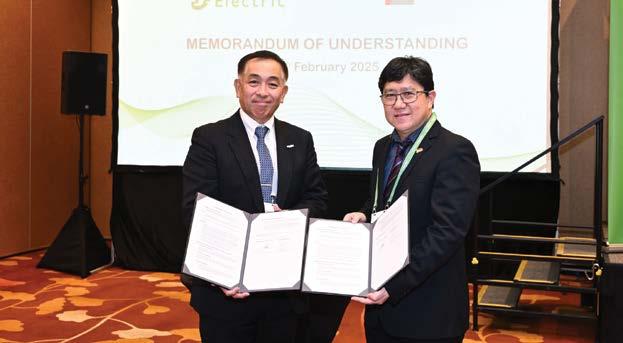
as well as joint content creation at CPG-hosted events and functions. Additionally, both companies will explore digital solutions and their applications to real-world challenges, and developing a white paper to advance industry insights.
Schneider Electric and CPG Corporation will also leverage each other’s strengths to drive sustainable solutions across various sectors. Schneider Electric will work with CPG’s Mechanical and Electrical, and Environmental Sustainability Design teams,
to propose energy-efficient solutions for sectors such as data centres and healthcare facilities, targeting at least two projects for implementation.
Schneider Electric will also partner with CPG’s Facilities Management team to explore initiatives such as energy audits, equipment upgrades and digital twin solutions, harnessing their combined expertise to enhance operational efficiency and sustainability, with at least one identified project.
CPG Facilities Management Pte Ltd (CPG FM), the facilities management arm of CPG Corporation, and Republic Polytechnic (RP) have signed a Memorandum of Understanding (MoU) to collaborate on a spectrum of initiatives aimed at developing future-ready talent and advancing sustainability in the built environment sector.
The MoU was signed by Mr Alan Goh, Chief Executive Officer of CPG FM and Mr Boo Chong-Han, Deputy Principal (Academic & Organisational Development) of RP. This partnership represents a significant milestone in industry-academia collaboration, laying the foundation for enhanced capability development, student engagement, curriculum innovation and applied research.
“Integrating sustainability, green building practices, and technology into the formative years of study helps students gain a practical understanding of current facilities management demands. As an industry partner, CPG FM is uniquely positioned to provide this handson experience, bridging real-world applications with classroom learning,” said Mr Alan Goh, Chief Executive Officer, CPG FM.
“This MoU serves as our ‘North Star’, guiding two organisations rooted in the north of Singapore –CPG FM and RP, towards nurturing future-ready talent, empowered with data-driven insights and smart solutions, to lead the FM industry into a smarter, greener future,” he added.
“The partnership between CPG FM and RP will help to build capabilities of the existing workforce and provide a ready talent pipeline to enter the built environment and sustainability sectors,” said Mr Boo Chong-Han, Deputy Principal (Academic & Organisational Development), RP.
“With the rise of smart building technologies and AI-driven
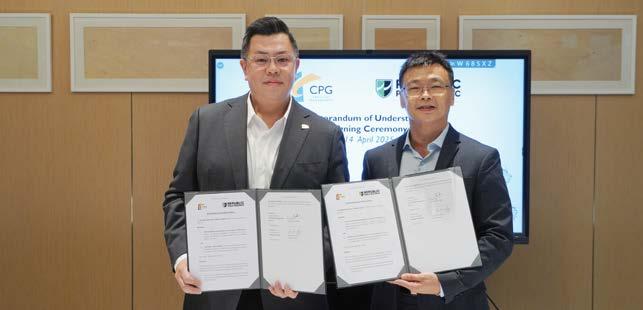
predictive maintenance in the facilities management industry, we are committed to working together with CPG FM on R&D projects to enhance operational productivity and streamline processes,” he added.
Since 2024, CPG FM and RP have collaborated on several initiatives to support the development of the FM industry and nurture future talent. Notably, they worked together on customer servicerelated training programmes such as the development of the Essential Maintenance Service Unit, which focuses on digitalising onboarding training and providing consultancy on experience journey mapping.
These efforts improve operational efficiency, standardise training processes and help build a more skilled workforce. At the same time, students gained valuable exposure to real-world FM challenges and hands-on experience in digital transformation, training design and communication, enhancing their readiness for careers in the sector.
The partnership also included initiatives aimed at productivity enhancement. One such initiative involved RP lecturers being attached to CPG FM to work on projects, including those that leverage data from the Computerised Maintenance Management System
(CMMS) to refine maintenance strategies, streamline call centre operations, and strengthen sustainability efforts.
Students who were involved in industry projects with CPG FM acquired practical skills in fault management, data analytics and sustainability, further boosting their employment prospects and industry preparedness.
Building on these past efforts, the MoU will serve as a platform to deepen CPG FM and RP’s shared commitment to advancing industry knowledge and talent development. Over the next five years, both parties will collaborate on joint initiatives across the following key areas:
Enriching student exposure and development
CPG FM and RP will co-organise industry talks, guest lectures and networking sessions, to broaden Pre-Employment Training (PET) students’ exposure to the industry. In addition, both parties will support student development, through the sponsorship of book prizes, awards and scholarships, for deserving students in the relevant courses.
Curriculum enhancement
CPG FM will provide industry insights to support RP in curriculum
advisory, module development, and the integration of case studies that reflect current and emerging industry trends.
Co-development of Continuing Education and Training (CET) and Workplace Learning programmes
CPG FM and RP will jointly develop Continuing Education and Training (CET) and Workplace Learning programmes in areas such as sustainability, facilities management, drone operations, decarbonisation strategies, placemaking and customer service.
Promoting careers in the built environment and sustainability sectors
Both parties aim to inspire the next generation to join the built environment and sustainability sectors by collaborating on outreach events, mentorship programmes, learning journeys, Final Year Projects (FYPs), internships and careermatching initiatives.
Capability development and research collaboration
CPG FM will provide RP staff with opportunities for professional
development through attachments, joint research projects and knowledge-sharing sessions, with CPG FM’s experts. Additionally, both parties will collaborate on Research and Development (R&D) initiatives, focusing on sustainable infrastructure, smart building technologies, tunnel maintenance and other innovationdriven projects.
Together, CPG FM and RP are committed to advancing industry capabilities, nurturing skilled talent and contributing to Singapore’s sustainable urban development goals.
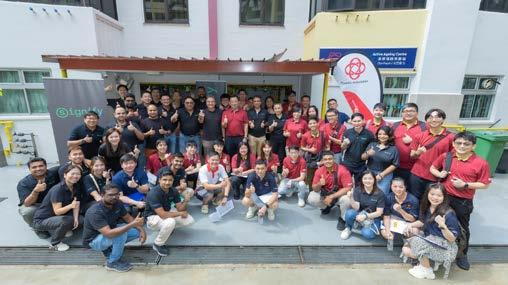
Signify, formerly Philips Lighting, a world leader in lighting, partnered with Toa Payoh East Community Club to donate more than 2,000 energy-efficient Philips LED light bulbs to 770 low-income households across three blocks in Toa Payoh East.
To encourage residents to adopt energy-efficient lighting products, Toa Payoh East Community Club identified eligible units and engaged residents in the initiative.
Three light bulbs were allotted to each household, which would brighten the homes and would also help to reduce energy consumption.
Mr Saktiandi Supaat, Adviser to Bishan-Toa Payoh GRC Grassroots Organisations, joined Mr Chandra Vaidyanathan, Managing Director of Signify Singapore & President

of Consumer Commercial AMEA (Asia, Middle East & Africa), along with a team of Signify employees and volunteers in the distribution of the light bulbs, and interacted with the residents.
To minimise the environmental impact of e-waste, the old bulbs were collected for recycling.
This CSR initiative was held over two weekends.
“We are truly grateful to Signify Singapore for their donation to support the low-income households in Toa Payoh. This initiative will have a significant impact on the lives of residents, and we commend Signify for their commitment to creating a brighter and more energy-efficient environment for our residents”, said Mr Saktiandi Supaat, Adviser to Bishan-Toa Payoh GRC
Grassroots Organisations.
“At Signify, we believe in the power of light to positively impact lives and uplift local communities. To be able to provide energy-efficient lighting to 770 households in Toa Payoh, in a neighborhood where our office has been located for more than 50 years, makes it even more meaningful,” said Mr Chandra Vaidyanathan, Managing Director of Signify Singapore & President of Consumer Commercial AMEA (Asia, Middle East & Africa).
This initiative underscores Signify’s ‘Brighter Lives, Better World 2025’ commitment to driving positive change within the community, and also aligns with the People’s Association vision of ‘A Nation that cares for our community’.
Nanyang Technological University, Singapore (NTU Singapore) and Trinasolar, a global smart photovoltaic (PV) and energy storage solutions provider, are collaborating to develop smart energy storage systems (ESS), to enhance efficiency, reliability and economic viability, in renewable energy applications.
As solar, wind, and hydrogen energy sources expand globally, energy storage technologies will play a critical role in ensuring power grid stability and optimising energy use.
Led by the Energy Research Institute @ NTU (ERI@N), the collaboration aims to develop AI-driven tools that can improve investment decisions, enhance system stability through intelligent energy forecasting, and deploy smart optimisation algorithms for diverse energy storage applications.
By combining Trinasolar’s expertise in PV and ESS technologies with NTU’s leading research in energy innovation, the collaboration seeks to address key challenges in smart energy storage, through the following three strategic focus areas:
• Smart investment decision-making Conventional energy storage investments often face uncertainties due to market volatility and evolving regulations.
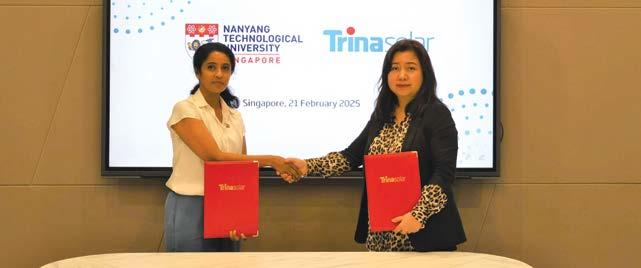
NTU and Trinasolar will develop a techno-economic modelling tool that integrates meteorological data, market regulations and electricity price trends, to generate optimal storage configurations. This tool will provide investors with clear economic metrics, such as return on investment (ROI) and payback periods, enabling better financial planning and risk mitigation.
• Ensuring system stability with AI-powered forecasting Renewable energy output is inherently intermittent, making energy management challenging. The team will develop machine learning-driven forecasting models that predict solar and wind energy generation, local electricity demand and market price fluctuations. These data-driven insights will enable energy storage systems to
Trinasolar, a global leader in smart PV and energy storage, has partnered with Venergy Solar to deliver a multibuild solar installation across the City of Playford in Adelaide, South Australia.
Six key council buildings have enhanced their green energy
credentials by installing solar across their rooftops, providing long-term energy savings and reinforcing the council’s commitment to driving clean energy in the region.
The large-scale rooftop rollout covers theatres, sports clubs and carparks, totalling 202 kW of
autonomously adjust charge and discharge cycles, ensuring a stable supply-demand balance, while maximising cost savings.
• Smart optimisation algorithms Energy storage systems must operate efficiently across different applications, from large-scale battery farms to commercial and industrial (C&I) energy storage. The partnership will develop intelligent energy management algorithms to enhance performance in areas such as energy arbitrage, peak shaving and ancillary services. These self-learning algorithms will enable energy storage systems to adapt in real-time, improving asset utilisation and profitability.
NTU and Trinasolar formalised their partnership through the signing of a technology research collaboration agreement.
installed capacity, reducing the council’s reliance on grid electricity and cutting carbon emissions.
Delivered by Venergy, a trusted provider of renewable energy solutions, the project saw the integration of Trinasolar’s highperformance Vertex S+ modules across all six sites.
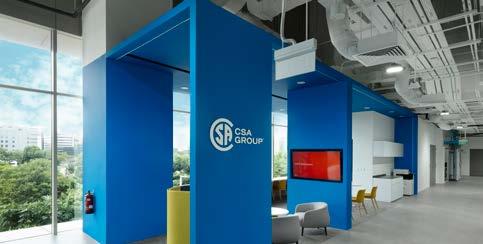
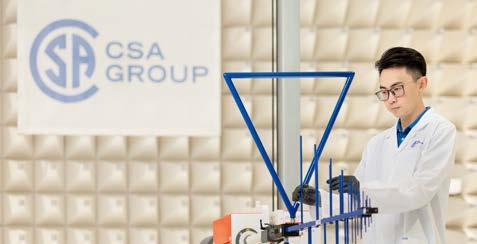
CSA Group has announced the opening of an advanced electromagnetic compatibility (EMC) laboratory in Science Park, Singapore – a hub for technology and innovation.
Supported by the Singapore Economic Development Board (EDB), this cutting-edge facility will provide efficient testing and certification services, helping manufacturers gain access to global markets.
Advanced testing capabilities to support product compliance
Equipped with the latest technology, the new laboratory enhances CSA Group’s ability to support manufacturers in meeting regulatory requirements and complying with regional and international standards. Key capabilities of the laboratory include:
• Advanced laboratory facilities: The EMC laboratory includes two cutting-edge, semi-anechoic chambers up to 10 m. These chambers help confirm that product testing is conducted accurately in complex electromagnetic environments.
• Wireless performance testing: Enhanced testing capabilities including essential evaluations of wireless communication devices, which include 4G and 5G NR(FR1), IoT systems, automotive electronics, and medical equipment, to help
confirm seamless and interferencefree operation.
• Electrical product testing: An enhanced electrical laboratory that offers efficient testing and certification services to help customers meet global safety regulatory requirements with localised service.
• Cybersecurity: Supporting manufacturers in protecting connected devices by testing for compliance with global cybersecurity standards.
This expansion strengthens CSA Group’s services for high-demand sectors, including Information and Communication Technology (ICT), artificial intelligence servers, industrial aplications, medical devices and more. The new facility will also serve as CSA Group’s ASEAN headquarters, and a base on which to grow further in the region.
“Singapore has established itself as a global hub for research, development and technological innovation, with a strong emphasis on fostering cutting-edge advancements across industries,” said Mr David Weinstein, President and Chief Executive Officer, CSA Group.
“CSA Group is proud to expand our presence here, strengthening our ability to support businesses in meeting evolving regulatory requirements and accelerating their
path to market,” he added.
“With the opening of our new laboratory, we are excited to offer our customers in Singapore and the ASEAN region advanced testing and certification services,” said Ms Frances Hung, Senior Vice President of East and South Asia, CSA Group.
“Our commitment to delivering trusted testing and certification services will help our customers meet regional and international standards to expand their market reach, while also supporting the delivery of innovative products globally,” she added.
“CSA Group’s expansion is a welcome addition to Singapore and will create new job opportunities in wireless communications, cybersecurity and electrical testing, said Mr Png Cheong Boon, Chairman of EDB.
“The new EMC lab will further enhance CSA Group’s capabilities in testing, inspection and certification to accelerate product development and commercialisation activities of companies in Singapore,” he added.
CSA Group
CSA Group is a global organisation dedicated to safety, social good and sustainability. The group is a leader in standards development and in product testing, inspection and certification, around the world.
Leng Aik Engineering Pte Ltd (LAE), a wholly owned subsidiary of EXEO Global Pte Ltd, the global headquarters of Tokyo Stock Exchange Prime Market-listed EXEO Group Inc, has launched an Advanced Design for Manufacturing and Assembly (DfMA) factory for Prefabricated Mechanical, Electrical & Plumbing (Prefab MEP) systems.
The factory, located on the 4th floor of LAE’s Soon Lee Road premises, aims to transform traditional MEP processes into a seamless, efficient and technologydriven workflow, replacing labourintensive, on-site construction, with digitally optimised, factorycontrolled manufacturing.
LAE has been a trusted name in the industry for over 20 years, specialising in electrical, plumbing & sanitary, and integrated building services for maintenance and system upgrades.
Since its acquisition by EXEO Group Inc, in 2018, the company has been building upon its strong technical expertise and capabilities, pursuing excellence in its engineering skills and driving innovation to meet the constantly evolving demands of the industry.
During the COVID-19 pandemic, the built environment sector suffered due to its reliance on foreign labour. To find ways to counter future pandemics, the team led by Mr Kimura Setsuya, Managing Director of LAE, was introduced to DfMA methods and studied it intensively, before embarking on the journey to invest in the development of the Advanced DfMA Factory.
Mr Kimura Setsuya, Managing Director of LAE, said, “The Singapore Government’s forwardlooking initiatives outlined in the refreshed Built Environment Industry Transformation Map (BE ITM)) and its support in helping firms adopt DfMA technologies
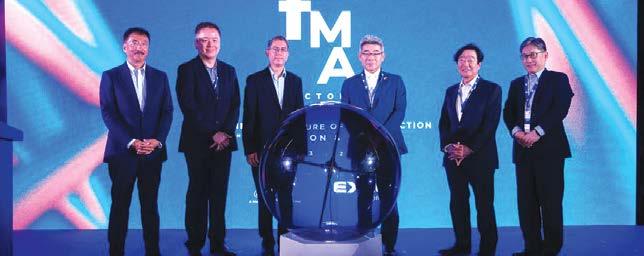
inspired us to take the leap forward to transform our business. We are proud to launch our Advanced DfMA Factory today, and hope that this will help benefit and drive continued innovation and transformation of the industry.”
With the strong support from the Building and Construction Authority (BCA), LAE successfully received Productivity Innovation Project (PIP) funding approval for the DfMA factory project, in July 2024, and kickstarted its development.
Mr Kelvin Wong, CEO of BCA, said, “I would like to congratulate EXEO Global and Leng Aik Engineering on the opening of their new Prefabricated Mechanical, Electrical & Plumbing (Prefab MEP) facility. The adoption of Robotics and Automation (R&A) and Integrated Digital Delivery (IDD) to enhance the fabrication and installation processes of Prefab MEP modules will improve production efficiency and quality. We look forward to more built environment firms leveraging R&A and IDD to boost productivity.”
Through the development journey, LAE worked closely with A*STAR SIMTech on recommendations to integrate technology tools and equipment into the factory floor and workflow.
For example, A*STAR SIMTech conducted a comprehensive automation assessment, using value stream mapping and process flow analysis, to identify opportunities for robotic and automated solutions. These insights enabled LAE to deploy solutions that optimise factory operations and meet production capacity goals.
At the Advanced DfMA Factory, LAE leverages Integrated Digital Delivery (IDD) technologies to create a seamless, end-toend digital workflow, ensuring greater efficiency and real-time workflow monitoring, throughout the modular construction and installation lifecycle.
The factory aims to provide its clients with one-stop Prefab MEP solutions using tools such as robotic welding, laser cutting, ARdriven inspection and automation, to ensure the delivery of highprecision modules to the built environment sector.
The factory’s motto ‘Innovation and Kaizen’ reflects its resolve to continue to explore new technologies and initiatives with A*STAR SIMTech, to ensure that it continually adopts modern and innovative construction methodologies and equipment.
Approximately USD116 billion will be needed to build out the existing colocation data centre pipeline across Asia Pacific, in the coming five to seven years, as demand for the sector grows, according to calculations by Cushman & Wakefield.
The global real estate services firm’s recently released H2 2024 Asia Pacific Data Centre Market Update report shows the pipeline of colocation projects in the region, either currently under construction or in late-stage planning, stands at 12,452 megawatts (MW).
Using the construction cost of a mid-specification data centre for each market as a benchmark, the total capital required to build out the pipeline currently sits at USD 116.2 billion.
By
Cushman & Wakefield estimates, this development pipeline provides an opportunity to generate over USD 14.9 billion in annual colocation rent and can potentially achieve almost 13% yield-on-cost ratio for developers.
Report author and Head of Research & Insights, Data Centre Group, Asia Pacific, Cushman & Wakefield, Pritesh Swamy, said, “Demand for the sector continues to grow – the Asia Pacific development pipeline is already three times greater than existing operational capacity and as demand for cloud, AI and large learning machine models increase, the CAPEX requirements continue to grow in scale.”
“The investment potential of the sector has well and truly captured
Structure Research, a leading independent research firm focused on cloud and data centre infrastructure, has released its latest 2025 Environmental, Social, and Governance (ESG) Report, providing an in-depth look at the environmental footprint of data centre providers and hyperscale platforms.
With sustainability metrics captured from 26 data centre operators and nine hyperscale cloud platforms, the report offers a snapshot into carbon emissions, energy consumption and water usage across the global infrastructure ecosystem.
The 2025 ESG Report finds that while data centre energy usage continues to rise – now accounting for more than 1.1% of global energy consumption – average carbon emissions per unit of energy consumed are trending downwards, driven by the growing adoption of renewable and carbon-free
energy sources.
Total energy usage increased from 178.5 TWh in 2019 to 310.6 TWh in 2024, while emissions intensity fell from 366.9 mtCO2e/ GWh to 312.7 mtCO2e/GWh, over the same period.
“Data centres are foundational to the modern digital economy, and that means they carry a growing environmental responsibility,” said Philbert Shih, Managing Director of Structure Research.
“What this report shows is that while energy consumption continues to climb, providers are making meaningful progress in efficiency and renewable adoption. The industry is clearly moving in the right direction – but transparency and accountability will be critical as sustainability expectations evolve,” he added.
KEY FINDINGS
Sustainability progress
• Energy usage by ESG Leaders
the attention of investors, as evidenced by the sector’s increasing share of annual real estate investment volumes,” he added.
Five markets account for 80% of pipeline
Of the 12.45 gigawatts (GW) in the pipeline (which excludes land banking activity and projects in early planning stages), over 80% is held in five markets – Japan, India, Australia, the Chinese mainland and Malaysia.
At a city level, Tokyo has the strongest pipeline within Asia Pacific, at 1,656 MW, followed by Mumbai (1,143 MW), Johor (1,049 MW), Sydney (783 MW) and Beijing (613 MW).
In these key cities, gross yield on cost increases to 14%.
grew 17.9% over the last five years, while renewable energy consumption increased by 27.9%.
• Hyperscalers now use renewable sources for approximately 91% of their total energy needs, data centre providers reached 62%.
• Carbon-free energy, including nuclear, is emerging as a key part of the data centre energy mix, as power constraints grow in Tier 1 markets.
PUE and water efficiency improvements
• Average Power Usage
Effectiveness (PUE) for data centre providers declined from 1.44 in 2019 to 1.38 in 2024, while hyperscale PUEs remained at an industry-leading 1.22.
• Data centre water consumption increased by 9.6% over five years, driven by demand for liquid cooling to support AI workloads and higher rack densities.
The investment addresses the AI data centre demand.
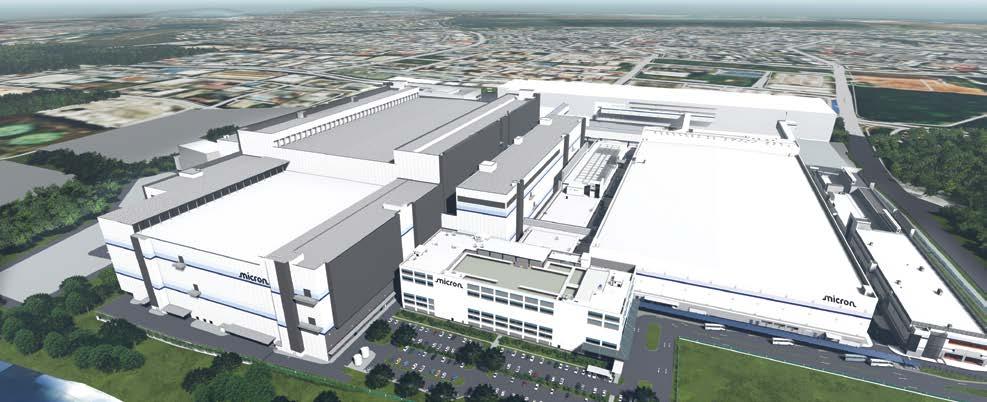
Micron Technology Inc broke ground, in January 2025, on a new High Bandwidth Memory (HBM) advanced packaging facility adjacent to the company’s current facilities in Singapore.
The company marked the occasion with a ceremony attended by the Guest-of-Honour, Mr Gan Kim Yong, Deputy Prime Minister and Minister for Trade and Industry of Singapore; Mr Png Cheong Boon, Chairman of the Singapore Economic Development Board; Mr Pee Beng Kong, Executive Vice President of the Singapore Economic Development Board; and Mr Tan Boon Khai, CEO of JTC Corporation.
The new HBM advanced packaging facility will be the first facility of its kind in Singapore.
Operations for the new facility are scheduled to begin in 2026, with meaningful expansion of Micron’s total advanced packaging capacity beginning in 2027 to meet the demands of AI growth. The launch of this facility will further strengthen Singapore's local semiconductor ecosystem and innovation.
“As AI adoption proliferates
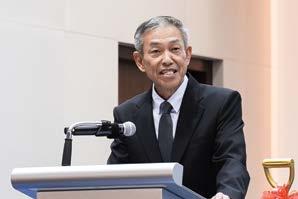
Mr Chen Kok Sing, Corporate Vice President and Singapore Country Manager of Micron Technology, presents the welcome address.
across industries, the demand for advanced memory and storage solutions will continue to increase robustly,” said Mr Sanjay Mehrotra, President and CEO of Micron.
“With the continued support of the Singapore government, our investment in this HBM advanced packaging facility strengthens our position to address the expanding AI opportunities ahead,” he added.
Micron’s HBM advanced packaging investment of approximately USD 7 billion (SGD 9.5 billion), through the end of the decade and beyond, will initially create around 1,400 jobs, which could, with site expansion plans, reach an estimated 3,000 jobs in the future. These new roles will
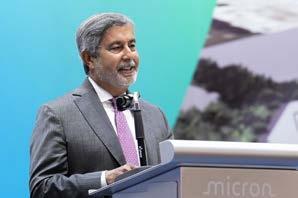
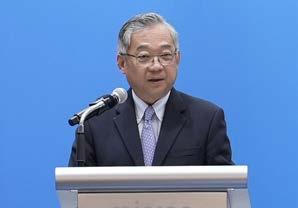
include functions such as packaging development, assembly and test operations.
Mr Png Cheong Boon, Chairman of the Singapore Economic Development Board, said, “We
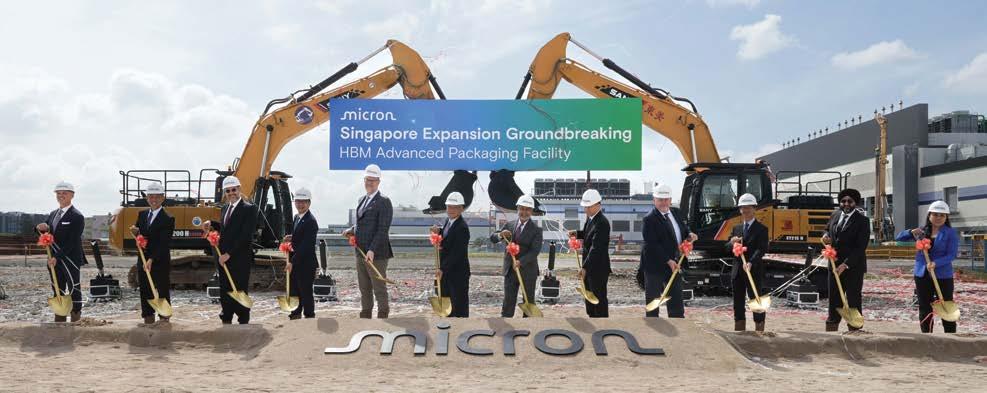
welcome this significant investment by Micron, which reflects its confidence in Singapore’s competitiveness as a critical node in the global semiconductor supply chain. This is Singapore’s first high bandwidth memory advanced packaging facility, allowing us to contribute to global AI growth. It expands Singapore’s partnership with Micron and further strengthens the semiconductor ecosystem in Singapore.”
Micron’s future expansion plans in Singapore will also support longterm manufacturing requirements for NAND. The company will maintain flexibility in managing the pace of capacity ramps in both the HBM and NAND facilities to align with market demand.
Micron’s current facility in Singapore is the first front-end semiconductor fab in the world to be recognised as the Advanced Fourth Industrial Revolution Lighthouse and Sustainability Lighthouse, by the World Economic Forum.
The new HBM advanced packaging facility will be built in alignment with Micron’s sustainability commitments. It will feature technologies such as greenhouse gas abatement, water recycling and waste circularity (reduce, reuse, recycle, recover). The new building will be highly automated through AI-based intelligent solutions and designed to meet the Leadership in Energy
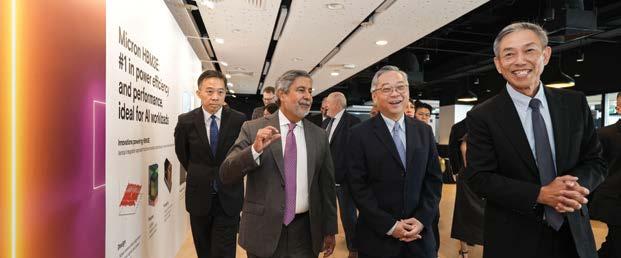
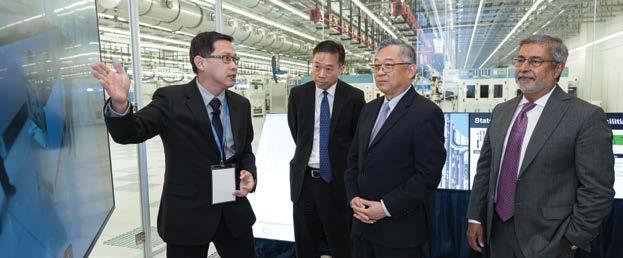
and Environmental Design (LEED) certification requirements.
Micron Technology Inc
Micron Technology Inc is an industry leader in innovative memory and storage solutions transforming how the world uses information to enrich life for all.
With a focus on its customers, technology leadership, and manufacturing and operational excellence, Micron delivers a rich portfolio of high-performance
DRAM, NAND and NOR memory and storage products through its Micron and Crucial brands.
The innovations from the company fuel the data economy, enabling advances in artificial intelligence (AI) and compute-intensive applications that unleash opportunities – from the data centre to the intelligent edge and across the client and mobile user experience.
Enhancing industry expertise to meet the demands of a greener tomorrow.
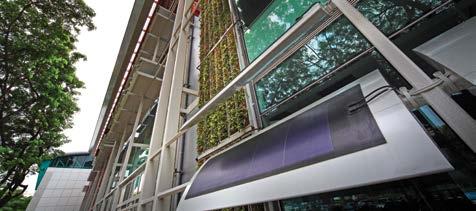
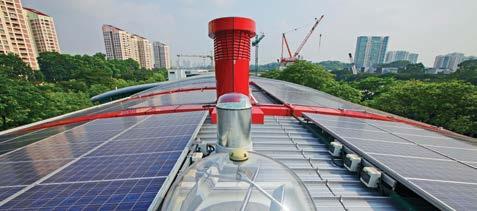
As the built environment continues to evolve, sustainability has become an essential focus for industries worldwide. The Building and Construction Authority (BCA) Green Mark 2021 (GM:2021) scheme demonstrates Singapore’s commitment to elevating industry standards and enhancing climate resilience.
In response to this vision, the BCA Academy has redesigned the Green Mark Advanced Accredited Professional (GMAAP) and Green Mark Advanced Accredited Professional (Facilities Management) [GMAAP(FM)] courses into the new Enhanced Green Mark Advanced Accredited Professional Course (Enhanced GMAAP). This restructured course is designed to provide professionals with the knowledge and expertise needed to lead sustainable building solutions in today’s dynamic built environment.
The Enhanced GMAAP introduces a flexible and modular learning approach, which allows learners to tailor their educational experience according to their career goals.
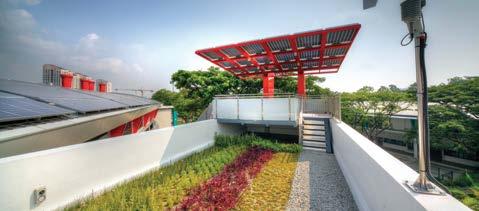

The course provides a wide range of stackable modules, giving learners the opportunity to pursue full certification or to focus on specific areas that align with their professional development.
Designed to accommodate the busy schedules of industry professionals, the programme allows learners up to two years to complete it, offering the flexibility needed to balance work commitments with educational goals. This selfpaced learning approach ensures that professionals can progress through the course at their own speed, making it more accessible for those with demanding workloads. Assessment is conducted through continuous evaluation, allowing for a more comprehensive and practical measurement of learning.
Additionally, learners can transfer credits earned through the course to partner universities of the BCA Academy, which accelerates their educational journey and opens up additional pathways for advanced learning.
The Enhanced GMAAP offers a
comprehensive curriculum designed to provide in-depth knowledge of green building solutions. The course structure consists of a 5-day core course, followed by 18 days of elective modules, offering learners the opportunity to specialise in areas of particular interest.
To ensure a holistic understanding of sustainability in the built environment, participants must complete at least one module from each of the following core areas: Active Design, Passive Design, Building Simulation, Operation and Maintenance, and Net Zero Carbon.
More than just a certification, the Enhanced GMAAP represents an investment in the future of the built environment. By fostering a skilled workforce equipped with advanced knowledge of sustainable practices, Singapore strengthens its position as a global leader in green innovation. Engineering professionals can enhance their expertise and contribute to the creation of ecoconscious, resilient buildings, helping to drive a more sustainable and greener future.
CATEGORY ENHANCED GMAAP COURSE – AVAILABLE MODULES
A Active Design
B Passive Design
C
Building Simulation
D Operation & Maintenance
E
Net Zero Carbon
Design, Optimisation and Measurement of High Efficiency Central A/C System
Efficient Building Envelope Design, ETTV & RETV
CFD Modelling for Natural Ventilated Buildings
Managing Buildings for Health and Wellness
Driving Energy Performance in SLE Buildings
Solar Architecture
Urban Heat Island (UHI) Mitigation Strategies
Building Performance Simulation Solar Modelling
Strategies for Smart FM and Maintainability
Sustainable Energy Management for Existing Buildings
Life Cycle Assessment: Carbon Computation and Management Strategies

The leading HVACR event also provided a platform to address regulation updates, AI, developments in equipment design, and more.
AHR Expo (International AirConditioning, Heating, Refrigerating Exposition) 2025 was held in Orlando, Florida, USA, from 10 to 12 February 2025.
The event provided opportunities for learning and reconnecting. It was also platform for demonstrating new HVACR products.
Topics spanning the various industry sectors were addressed, including tariffs, regulation updates, A2Ls, AI, equipment design, and more.
AHR Expo 2025 featured the displays of 1,878 exhibitors, spread over an area of 516,060 ft2 and attracted more than 50,000 visitors.
The Podcast Pavilion hosted a record 22 podcasters hosting interviews with industry personalities and covered all the latest topics impacting the industry.
The 2025 Education Program offered more than 300 sessions. The topics covered included pain points, opportunities and methods to increase efficiency, business practice and cross-sector relationships. Of the sessions, 145 were new product presentations in New Product Theaters and seven panels in the AHR Panel Series.
In the 2025 State of the Industry Panel discussion, the topics included tariffs and their potential impact, A2Ls and a visionary look to A3Ls, as well as a look ahead at market shifts.
Other popular sessions included topics such as the transition to A2Ls; the rise of Artificial Intelligence (AI) in the industry; cybersecurity considerations; workforce development, including actionable strategies to grow a team now; new regulations at the state, federal and global level; and more.
The 2025 Product of the Year winner was PassiveLogic, for the product ‘PassiveLogic Sense Nano’, in the category ‘Tools & Instruments’. The Sense Nano is a wireless sensor, communicating via Bluetooth mesh, while extracting its operating energy from the surrounding environment.
The show floor also presented the products and technologies of the winners of the 2025 AHR Expo Innovation Awards. Winners are chosen annually in 10 industry categories, representing the most innovative products and technologies in the market.
AHR Expo is the world’s premier HVACR event, attracting a comprehensive gathering of industry professionals from around
the globe each year. The show provides a unique forum where manufacturers of all sizes and specialities, whether they are major industry brands or innovative startups, can come together to share ideas and showcase the future of HVACR technology, under one roof.
Since 1930, AHR Expo has enabled OEMs, engineers, contractors, facility operators, architects, educators and other industry professionals to explore the latest trends and applications, and cultivate mutually beneficial business relationships.
AHR Expo is co-sponsored by ASHRAE and AHRI and is held concurrently with ASHRAE’s Winter Conference.
The next edition of AHR Expo will be held from 2 to 4 February 2026, in Las Vegas, Nevada, USA.
AHR Expo is produced and managed by International Exposition Company Inc.
Building Automation
Winner: Distech Controls
Innovation: Eclypse Facilities
Cooling
Winner: Climate Control Group
Innovation: EnviroKIT
Heating
Winner: AERCO, A Watts Water Company
Innovation: AERCO CFR
Indoor Air Quality
Winner: Senva Inc
Innovation: TotalSense IAQ sensor
Plumbing
Winner: Grundfos
Innovation: Grundfos ALPHA HWR
Refrigeration
Winner: Danfoss
Innovation: Danfoss BOCK HGX56 CO2 T
Software
Winner: Radiant
Professionals Alliance
Innovation: Building Efficiency System Tool 6.2 (BEST 6.2)
Sustainable solutions
Winner: LG Electronics USA Inc
Innovation: LG
Residential Cold Climate Heat Pump
Tools & instruments
Winner: PassiveLogic
Innovation: PassiveLogic Sense
Nano
Ventilation
Winner: Rosenburg USA Inc
Innovation: Rosenberg I-Series Backward Curved Fans
Over 90% of IT leaders are rewriting their cloud strategies as hybrid cloud and AI take centre-stage.
A recent global survey of more than 1,400 IT decision-makers conducted by Rackspace Technology, a leading end-to-end, hybrid, multicloud and AI solutions company, found that organisations continue to shift away from a single cloud approach towards more flexible hybrid cloud environments.
Over 90% of the Singapore survey respondents reported that they plan to make significant changes in their cloud strategy over the next two years. Of those respondents, 47% said that a hybrid cloud for multi-environment deployment will be critical to their IT operations over the next 12 to 24 months.
The main reasons for Singapore respondents to utilise a hybrid cloud environment include improved reliability and availability (89%), followed by meeting evolving business needs and scalability (56%).
Despite the steady adoption of public clouds, IT teams are not preparing to abandon private clouds. Over 72% of Singapore respondents stated that their organisations had considered repatriating at least a portion of their workloads from public clouds back to private clouds or on premises infrastructure, citing data security and compliance requirements (48%), better integration with existing systems (40%), and unexpected cloud service downtime or reliability concerns (38%), as rationales.
For those that had recently repatriated workloads, nearly 80% of respondents reported that it had resolved those concerns.
Although the importance of cloud deployments is widely recognised, the survey reveals a significant gap in their full adoption among enterprises. Only
7% of Singapore respondents reported that cloud adoption is fully integrated into their business strategy and aligned with their business objectives, with advanced practice areas in place.
“As AI continues to drive rapid advancements, IT leaders are re-evaluating their approach to workload management. Instead of updating existing infrastructure, they are designing entirely new cloud strategies to meet evolving demands,” said Srini Koushik, President AI, Technology and Sustainability at Rackspace Technology.
“To future-proof their organisations, many are transitioning from a ‘onesize-fits-all’ model in favour of a more flexible and resilient multi-strategy approach,” he added.
“For Singapore organisations to achieve business and technology benefits such as operational efficacy and enhanced data analytics and insights, it is imperative for organisations to develop a clear AI and cloud strategy,” said Adhil Badat, Chief Operating Officer for Asia-Pacific Japan at Rackspace Technology.
A driving force behind the desire for multi-solution approaches is the ease with which organisations can move data between different cloud environments, with 80% stating that they can transfer workloads seamlessly between the public and private cloud, and 85% reporting that they can do so between multiple public cloud hyperscalers.
Development of AI initiatives remains a key focus for IT teams, with 88% of Singapore respondents reporting that they have taken steps to integrate their AI and cloud strategies. When asked
about the business outcomes that were driving the integration of AI and cloud, 49% of Singapore respondents reported that their goal is to enhance operational efficiency while 40% are leveraging AI to improve the insights generated by data analytics.
Although IT leaders are bullish on cloud and AI integrations, talent and resource shortages remain major pitfalls that could limit their ability to fulfil these goals. Ensuring data security and compliance was cited by 49% of respondents as a constraint, followed by insufficient budgets that limited their ability to meet business demands (47%).
This trend is consistent with insights from Forrester’s 2024 State of Cloud in the US Report. The research found that US enterprise cloud decision-makers saw AI/ML as the most critical cloud technology area, with 24% looking to hire new staff skilled in these areas, and an additional 25% planning to retrain existing staff to meet these needs.
Enterprises remain bullish on their efforts to integrate AI and more advanced cloud strategies. 46% of Singapore respondents listed Cloud Native AI/ML Services as one of their top priorities, followed by multicloud and hybrid cloud optimisation (42%), and cloud-based sustainable computing (40%).
98% of Singapore organisations surveyed have established procedures and policies for data privacy and compliance in cloud environments. 35% of Singapore respondents report that they are leveraging AI for advanced security and threat detection.
by Han-Tiong Law, Regional Chief Technology Officer, Asean and Greater China, Rimini Street
Digital transformation: Industry 4.0 to Society 5.0 is a strategic requirement for manufacturers, with many decision-makers recognising it as a top priority. The World Economic Forum reports that 70% of new value created in the economy, over the next decade, will be based on digitally enabled platform business models.
However, high costs and associated risks continue to be a barrier to acceleration for manufacturers, particularly in Singapore, where 64% of businesses report facing this hurdle, according to a survey by the Singapore Business Federation (SBF).
While resource constraints may make it difficult for businesses to progress beyond the initial pilot stages of their digital transformation vision, this state of arrested development can be overcome by embarking on nontraditional, proven paths that have helped thousands of organisations refocus their limited IT resources towards innovation and growth.
Know what you are paying for
A means to overcome budget constraints, cost-saving strategies allow manufacturers to discover, re-prioritise and fund meaningful optimisation and digital transformation. And it starts by knowing where your money is going, and the ROI of each allocation. One of the heftiest costs to an organisation is often the overhead cost of maintaining mission-critical systems such as enterprise resource planning (ERP) software.
Typically, the annual maintenance fee for ERP customers comes in at 22% of their annual licence, which
for some, can mean millions of dollars per year. For those who are on the latest release, available by upgrades or re-implementation, the package comes with vendor support, tax, legal and regulatory (TL&R) updates, security patches when available, and promise of new features.
For those who are on releases that are older, like many manufacturers, they typically pay the same 22%, but cannot get the latest security patches and TL&R updates for compliance, or have access to new features. Neither do they get support for any customisations made on their ERP, which means organisations will need to find additional resources to bridge the gap.
Luckily, manufacturers have found a better way.
With the right third-party software support partner, IT leaders can find and release much savings on software maintenance, getting better and more comprehensive support and TL&R updates for multiple countries, proactive security protection, and more value for less.
Perhaps the most important benefit is that with their systems stable and the need for upgrades no longer on the table, manufacturers are free to explore and add only new features and functionalities they want and need, on top of their existing systems, without delay.
Singaporean manufacturers that are adopting this proven strategy are freeing up funds to invest in emerging technologies like artificial intelligence (AI), machine learning (ML), Industrial Internet of Things (IIoT), industrial automation and robotics, and supply chain
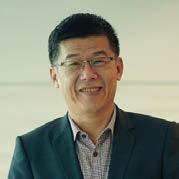
digitalisation. This method has become especially relevant as organisations seek to optimise and transform without increasing their resources.
With more cost-effective support solutions, manufacturing leaders can redirect time and resources away from daily support tasks and towards mid- to long-term projects that correspond with strategic business goals. This change not only increases IT operational efficiency, it also accelerates the IT rate of innovation towards digital transformation.
Furthermore, financing options such as the expanded Enterprise Financing Scheme (EFS) can improve manufacturers’ access to funds, at various stages of development. This can help them fulfil cash flow requirements and invest in transformative initiatives. These combined strategies can free up IT teams to focus on initiatives that boost agility, resilience and competitiveness.
With these strategies in place, manufacturers can focus on optimising and transformation initiatives to stay competitive in a digitally driven industry.
According to Gartner research, 35% of organisations are unable to allocate dedicated resources across core supply chain tasks such as planning, procurement, logistics and manufacturing, due to limited resources.
According to the SBF National Business Survey, manufacturers are part of the top four industries citing availability of manpower as a challenge. This lack of dedicated support makes it difficult for firms
to manage digital transformation alongside daily operations, restricting their ability to adjust to market changes and quickly deploy innovations – emphasising the need for cost-effective, strategic solutions.
Given these industry-wide demands and challenges, manufacturers must implement targeted strategies to get beyond the early stages of digital transformation. This is where choosing third-party software support comes to the rescue, once again.
The overhead costs and risk of managing complex systems cannot be underestimated. With some releases getting limited support service level agreement from vendors, the rising cost of managed services and the cost of labour, manufacturers must find a way to identify where they can have operational excellence without sacrificing business resilience.
Selecting third-party support for existing systems is a foundational strategy adopted by manufacturers to immediately reduce manpower costs, shifting the work from internal resources to a trusted partner. When the same thirdparty support provider can also take on managed services with a model designed for root cause analysis and permanent fixes, all at a predictable cost, this allows for even more savings with less handoff challenges prevalent with managing multiple vendors.
More freed internal resources will allow manufacturers to focus their team’s time towards optimisation and transformation, bringing the organisation closer to its digital goals.
Adopting digital tools such as AI/ ML, industrial automation and IoT allows manufacturers to increase agility, productivity, efficiency and personalisation. However, realising the advantages of digital transformation requires more than just adopting advanced
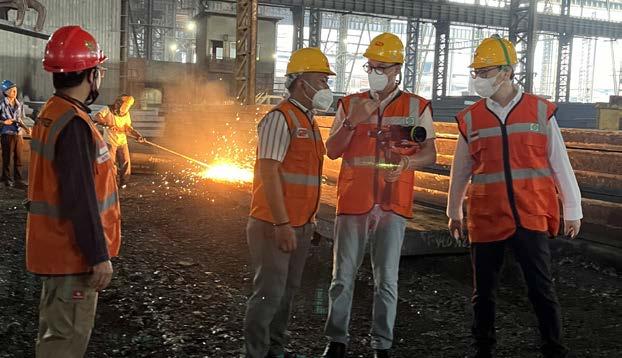
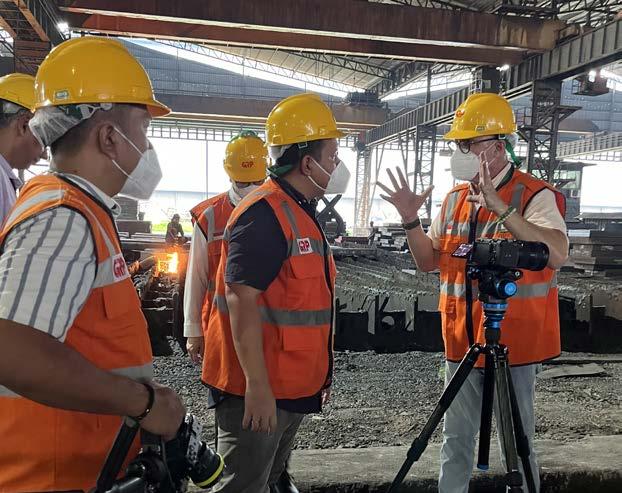
technologies. It requires sustainable resource management and adaptability.
Here is where third-party support comes in, once again – as it allows manufacturers to regain control over their digital transformation roadmaps. Providing the flexibility needed to traverse digital disruption, third-party support helps optimise a transformative approach that reduces dependency on vendor-imposed updates.
This move also allows IT teams to experiment with new technologies. With this independence, businesses may quickly re-align their focus on
business first innovative solutions and successfully respond to changing market demands.
For Singaporean companies and those establishing operations in Singapore, that are leveraging third-party support, combining optimisation and transformation makes it easier to prioritise strategic projects that enhance agility, resilience and competitiveness. This is a proven path towards advancing growth and profitability goals, empowering manufacturers to take control of their IT roadmap, budget and destination, for competitive differentiation.
by Tobias Unosson, Partner Manager – Digital Products and Services, Sandvik Coromant
Sharing insights to mark the World Day for Safety and Health at Work on 28 April.
Machining has always been a hands-on job. Operators depend heavily on their experience and instincts, often working in close proximity to heavy equipment, sharp tooling and fast-moving components. While manual skills are still vital, the growing adoption of digital tools has introduced safer ways to monitor and manage complex machining tasks.
This shift is especially critical, as the industry continues to grapple with a growing skills gap. With a projected deficit of 7.9 million manufacturing workers globally by 2030, according to a recent Korn Ferry study, the need to ensure safety for less experienced operators is more urgent than ever. It is essential that newer workers are equipped not only with the right skills but also with technologies that protect their safety and wellbeing.
The rise of remote monitoring
Remote monitoring has emerged as a powerful tool for improving operator safety, offering realtime visibility and enabling early detection of potential issues. In many machine shops, operators still rely on visual cues or manual measurements to assess things like vibration, heat build-up or tool deflection. These checks often require getting physically close to the workpiece, especially during setup or troubleshooting, introducing risks in environments that are already hazardous.
With digital tooling, many of these tasks can now be performed from a distance. Sensors embedded in cutting tools or tool holders track key parameters like load, vibration, deflection and temperature, as the
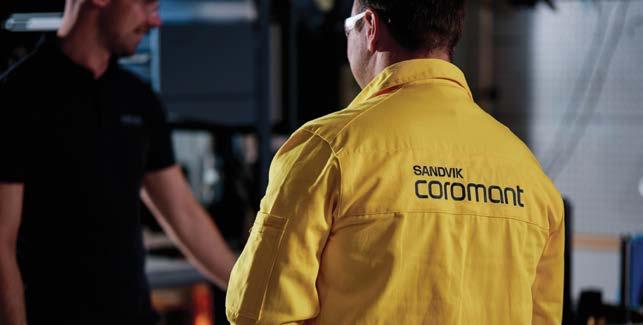
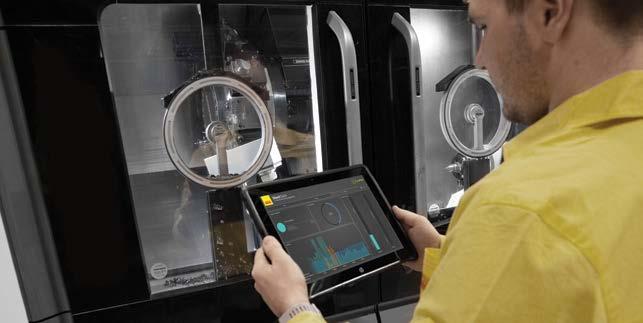
Workers need to be equipped not only with the necessary machining skills but also with the technologies that ensure their safety and wellbeing.
machining process runs. This data is then transmitted to a display interface, tablet or even directly to the CNC machine, enabling operators and engineers to monitor performance in real-time without being right next to the spindle.
A closer look at vibration
Vibration is a common challenge in many machining operations and while it is often associated with part quality or tool life, it also has implications for operator
safety. Excessive or uncontrolled vibration increases the likelihood of unexpected machine behaviour, which can lead to tool breakage, damaged workpieces or even accidents that put operators at risk. Typically, operators detect dangerous vibration through audible resonance or by feeling unusual movement in the machine. But by the time those signs become noticeable, it is often too late to prevent damage or safely intervene.
Digital tooling has changed this dynamic. With sensors embedded in tools and tool holders, vibration levels can be continuously monitored, offering early warnings when conditions begin to shift. This allows operators to make proactive adjustments, such as modifying feed rates or spindle speeds, before instability becomes a serious issue. Advanced systems such as Silent Tools Plus, Sandvik Coromant’s sensor-equipped turning adaptors, take this a step further. When paired with CNC machines using CoroPlus Connected technology, these systems can automatically mitigate machining issues, such as initiating a stop and retract, when vibration exceeds safe thresholds, based on limits set by the operator. Connected, integrated tooling like this reduces the level of manual intervention needed, offering significant benefits for highprecision or lights-out machining operations.
In applications such as aerospace or mould and die manufacturing, these capabilities are especially valuable. Long overhangs, thinwalled parts and delicate materials all make vibration more likely –
and more dangerous. Real-time feedback helps engineers maintain cutting stability and safety while reducing the need for frequent manual checks.
Beyond immediate risk reduction, digital tooling also contributes to long-term operator health. Continuous exposure to vibration, heat and noise can lead to chronic issues such as hearing loss or repetitive strain injuries. By minimising the need for close-up inspections and manual monitoring, digital technologies help reduce these physical stressors and support safer working conditions over time.
This is one way digitalisation supports Sandvik Coromant’s broader philosophy of Manufacturing Wellness, a holistic approach to building more sustainable and resilient manufacturing operations. Sandvik Coromant notes eight key habits that improve manufacturing wellness, including adapting to new technology, embracing datadriven insights and developing your people.
This mindset encourages manufacturers to think beyond short-term productivity and focus on creating operations that are adaptable, efficient and healthy for the people who run them. Reducing physical strain, minimising unplanned interruptions and improving control over machining conditions are all key steps toward a safer and more sustainable future.
As the manufacturing industry continues to adopt digital solutions, it is crucial that safety remains a key priority. By embracing smarter, more connected tools and processes, manufacturers can protect their most valuable assets – their operators – while enhancing the performance and longevity of their machines.
Sandvik Coromant Sandvik Coromant supplies tooling solutions to the world’s engineering industries. Over eight decades of hands-on experience have given the company a wealth of knowledge in metal-cutting and machining. Sandvik Coromant is part of global industrial engineering group, Sandvik.
Sandvik Coromant has introduced the full lineup of its nextgeneration Silent Tools turning adaptors. Additional sizes and configurations have been added, including adaptors with Coromant Capto coupling and HSK-T coupling. Furthermore, this innovative vibration-damping technology is now available for quick and easy customisation with Tailor Made.
Sandvik Coromant has now added 75 Coromant Capto adaptors (diameters 32 mm to 100 mm and 1.260 inch to 3.937 inch) and six HSK-T adaptors (diameters 32 mm to 60 mm and 1.260 inch to 2.362 inch) to the
existing assortment.
The advanced damping mechanism efficiently counters vibration forces, ensuring safer machining at long overhangs and reducing the risk of interruptions and incidents. Ensuring significantly more consistent performance across different length-to-diameter ratios, the damping mechanism translates into increased machining repeatability and reliability.
The next-gen technology of Silent Tools turning adaptors addresses key industry challenges, including increasing metal removal rates, improving surface finishes, enhancing
process security and reducing production costs. By minimising disruptions during internal turning operations, Silent Tools lowers the cost per component, making businesses more profitable and competitive.
The updated assortment of Silent Tools turning adaptors now consists of 187 tools in total, including cylindrical, Coromant Capto and HSK-T adaptors. These tools are ideal for general internal turning, parting and grooving, and threading, in various industry segments, including aerospace, power generation, oil & gas, general engineering and machine tool making.
by Doris Schulz, Journalist, Korntal, Germany
Ultrasound for intermediate and final cleaning of medical devices.
The manufacture of medical technology products such as implants, instruments and devices is subject to very strict requirements – including for parts cleaning. The use of ultrasound is an indispensable process, here. It ensures that the required cleanliness is achieved in a stable, efficient and sustainable manner, during both intermediate and final cleaning.
The combination of ultrasound and medical technology was initially associated with diagnostic imaging. However, ultrasound can do much more in this area.
Sound with frequencies above the human hearing range has established itself as an economical and sustainable standard process for wet-chemical cleaning applications in the manufacture and reprocessing of medical technology products such as instruments, implants and other devices. And it can be used for components made of a wide variety of materials such as stainless steel, titanium, cobalt-chrome alloys, ceramics and plastics.
Optimally adaptable to the task
In cooperation with cleaning system manufacturers and users, Weber Ultrasonics develops custom-designed generators and transducer systems, such as rod, plate and immersible transducers, with different frequencies for different cleaning tasks in medical technology applications.
This includes single-frequency solutions as well as dual- and multifrequency ultrasonic systems in a frequency range from 25 kHz to 132 kHz. They enable the construction of space-saving cleaning systems that are individually tailored to the workpieces and cleaning
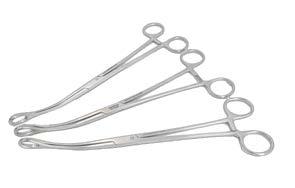
Ultrasonic cleaning is the standard procedure for medical technology products such as instruments, implants or other devices with very high cleanliness requirements.
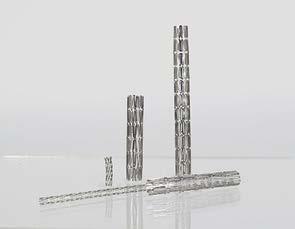
Very high cleanliness requirements are placed on delicate implants such as stents, and cleaning must be very gentle, which can be ensured by ultrasonic cleaning. Image: Weber Ultrasonics.
requirements. The development of vacuum-proof, single, dual and multi-frequency immersible transducers also opens up the use of ultrasonic cleaning in fullvacuum cleaning systems.
For high-purity applications, where particularly high demands are placed on component cleanliness and cleaning equipment, immersible transducers and plate transducers are available in a suitable design. With a surface roughness of < 0.35 µm, they meet the requirements of hygiene class 4, in accordance with DIN 11866.
Cleaning stents reliably and without damage
Heinz Schade also relies on the wide range of highly effective ultrasonic components. Founded
in 1999 and based in Reutlingen, Germany, the company develops and produces machines for balloon and catheter production as well as stent processing, which are sold worldwide.
In addition, there is software that is optimally adapted to the various machines and, among other things, enables the seamless documentation and traceability of processes required in medical technology. This helps to ensure that the strict requirements of the Medical Device Regulation (MDR), with regard to process and product safety and quality management, are met.
One focus of the system portfolio is on the manufacturing steps for stent production, that follow laser cutting, such as electropolishing, heat treatment, pickling and ultrasonic cleaning. The company has been manufacturing tanks for cleaning systems, in-house, for around 20 years.
This allows them to be adapted to the various products and the specific requirements of the respective customer.
“With our own production facilities, we were looking for a supplier for the ultrasonic components. In Weber Ultrasonics, we found a partner that has impressed us to this day with its expert advice and uncomplicated cooperation,” said Heinz Schade, Managing Director, Heinz Schade.
To ensure the quality and safety of the products, the stents are usually cleaned between the various processes. Final cleaning is then carried out before packaging, usually in a clean room.
“Increasingly stringent surface cleanliness requirements have to be met. At the same time, it must be ensured that the sensitive stents

are not damaged during cleaning. The key parameters for this are the frequency of the ultrasound and the power in watts per litre of bath volume. In addition, a homogeneous sound field must be generated in the bath, to ensure a consistently stable result,” said Heinz Schade.
“The ultrasonic solutions from Weber Ultrasonics are ideal for these tasks. The power can be set very precisely by controlling the generator and the sound output is constant and reliable. We have had no problems with the ultrasonic systems so far,” he added.
Removal of particulate and filmchemical impurities
Ultrasound develops its cleaning effect in a liquid bath through the physical effect of cavitation. The electrical signals generated by an ultrasound generator are transmitted into the liquid, through oscillating elements.
The sound pressure is characterised by an alternation of negative and positive pressure. In the negative pressure phases, microscopically small cavities are formed, which collapse (implode) in the subsequent positive pressure phase. This creates shock waves, with considerable energy, which ‘blast off’ particulate and filmchemical contaminants.
At the same time, microcurrents are created in the liquid, which flush away detached or dissolved contaminants. These effects make it possible to remove contaminants
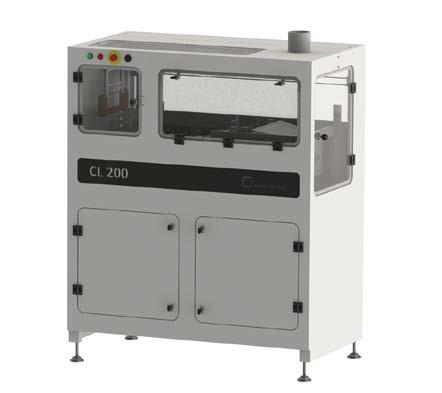

The key criteria for stable and damage-free cleaning of the stents include a homogeneous sound field in addition to an optimally tuned ultrasound frequency and power. Image: Weber Ultrasonics.
not only from the surface, but also from complex geometries, cavities, holes and structures.
of ultrasound with pressure cycling processes
For components such as additively manufactured implants with an open-pored sponge structure or combined porous and polished surfaces, as well as components with very fine capillaries, ultrasound can be combined with pressure cycling processes.
In these vacuum flood cleaning processes, alternating negative and positive pressure and cavitation effects are generated by regularly repeating pressure changes. This
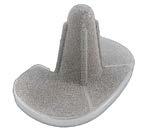

For products with an open-pored sponge structure, with combined porous and polished surfaces and components with very fine capillaries, ultrasound can be combined with pressure cycling. Image: Weber Ultrasonics.
allows cleaning and rinsing media to reach areas that would otherwise be reached only to a limited extent or not at all.
Human expertise remains essential to ensure safety and accuracy in maritime operations.
As the shipping industry rapidly adopts AI-driven systems for machinery testing and diagnostics, CM Technologies GmbH (CMT), a leading provider of testing and monitoring technology, acknowledges the growing potential of these technologies to process vast quantities of data and assist with condition monitoring tasks. However, the company insists that human engineers must remain ‘in the loop,’ to validate, interpret and act upon technical data, particularly aboard increasingly complex and automated vessels.
“AI has a role to play, certainly – especially when it comes to analysing huge data sets generated during operations,” said CMT’s Managing Director, Mr David Fuhlbrügge.
“But there are critical limitations in relying on technology alone. A sensor can tell you a pressure reading or temperature value. It cannot smell burning oil, feel excessive vibration or recognise an unusual sound in the engine room. That is where human intuition, experience and judgement come in,” he added.
The company currently does not embed AI in its own monitoring devices, relying instead on sophisticated algorithms to provide reliable data interpretation.
The company suggests that in the future, AI and sensors will be relied upon to flag issues remotely. But crucially, these alerts will still require expert human evaluation, often from shore-based engineers in contact with onboard or visiting crews. CMT envisions a likely shift towards a hybrid model where monitoring is continuous during voyages, with mobile maintenance teams dispatched to address problems in port.
“Ultimately, we anticipate a
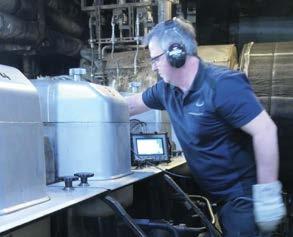
setup similar to today’s engine manufacturer service models. Sensors might identify a fault midvoyage, and a flying repair team would meet the vessel at the next port. But without someone qualified to interpret those readings correctly, there is a serious risk of either false alarms or overlooked faults,”
Mr Fuhlbrügge continued.
The concern is compounded by the technical and financial burden of deploying high numbers of reliable sensors across all areas of a ship, especially if these systems themselves become points of failure. AI still lacks the ability to emulate the ‘gut feeling’ that seasoned engineers develop through years of experience – a critical quality when diagnosing nuanced mechanical issues.
“The shipboard engineer is effectively a multi-sensory detector. The engineer notices smells, vibrations, small changes in behaviour – things no current AI or sensor suite can reliably do. That kind of holistic insight is still uniquely human, and indispensable,” said Mr Fuhlbrügge.
CMT stresses that rather than seeking to replace engineers, AI should be used to augment their abilities, enhancing maritime safety and efficiency through collaboration between people and machines.
“Seasoned engineers see AI as a useful extension of their own insight. But younger professionals, by contrast, are often more enthusiastic about the prospect of fully automating decision-making, even to the point of removing human involvement. This is as much a cultural shift as it is a technological one,” said Mr Fuhlbrügge.
While acknowledging the longterm potential of machine learning to replicate more sophisticated aspects of human reasoning, CMT warns that significant obstacles remain. Chief among them is the need for massive, diverse and highly contextual datasets to train such systems effectively, as well as the enormous energy requirements to power advanced neural networks – challenges that are yet to be resolved.
In the meantime, the company calls on industry stakeholders to adopt a balanced and pragmatic approach.
“Let us not be blinded by the promise of the full autonomous ship. Human engineers are not a relic of the past. They are the best safeguard we have for a safe and reliable future at sea,” said Mr Fuhlbrügge.
CMT develops diagnostic systems for engine performance and fuel quality monitoring, and has supported ship operators and engine manufacturers worldwide, for over two decades.
The company’s solutions provide real-time analysis of wear metals, combustion parameters and fuel contamination – critical indicators of machinery condition. The company’s portable and onboard systems are widely used to help prevent failures, optimise maintenance and improve vessel efficiency.
by Antoinette Hodes, Global Solutions Architect at Check Point Software Technologies
As the world embraces IoT technologies, the associated risks and vulnerabilities become increasingly prominent. Traditional IT incidents and IoT incidents differ not only in their nature but also in the full spectrum of costs they impose on organisations.
This article examines these differences in detail, providing an analysis of the often-overlooked expenses specific to IoT incidents. By quantifying the economic impact of IoT security breaches and contrasting them with traditional IT incidents, we underscore the hidden financial repercussions that IoT incidents can have across sectors.
The rapid growth of IoT has transformed industries, promising connectivity, automation and data-driven decision-making. However, these benefits come with considerable risks. Unlike traditional IT systems, which are designed with a significant focus on security and resilience, many IoT devices prioritise functionality, leaving substantial security gaps.
When breaches occur, the financial ramifications extend beyond the typical costs associated with IT incidents. This article delves into these unique financial costs, highlighting why IoT incidents pose a different set of challenges compared to traditional IT security breaches.
For instance, IBM estimates that the average cost of a data breach is approximately USD 4.88 million [1], encompassing the primary cost factors. However, traditional IT infrastructure is usually easier to secure, due to the presence of standard security solutions and established compliance frameworks.
The financial implication of an a IoT breach is estimated at USD 195,428. The biggest cost amplifiers are security system complexity, security skills shortage and noncompliance with regulations.
Cost drivers of IT incidents
Traditional IT incidents, such as data breaches, denial-of-service attacks and ransomware, have well-
documented costs. These generally include:
• Direct financial loss: Immediate financial implications, such as ransom payments or lost revenue from service downtime or disruptions.
• Regulatory fines and legal fees: Regulatory compliance bodies impose fines, and legal fees often accrue when handling data breaches.
• Operational disruption: Organisations face workflow interruptions, decreasing productivity and impacting profitability.
• Incident response and recovery costs: Costs for technical recovery, remediation, employee overtime and forensic analysis add up.
Unique cost drivers of IoT incidents
IoT incidents, however, introduce additional layers of costs that organisations may not be prepared for. These include:
• Broad attack surface and exposure: The distributed and interconnected nature of IoT devices increases exposure and potential access points for attackers, resulting in larger-scale incidents that can compromise the entire IoT and IT ecosystem.
• Limited control and legacy IoT: Many organisations deploy legacy IoT devices that lack robust security features. These devices often operate on outdated software with known vulnerabilities, leaving
them susceptible to exploitation. The limited control over these devices complicates security efforts, necessitating significant resources for upgrades or replacements.
• Physical impact and safety risks: IoT incidents can have tangible physical impacts, especially in critical sectors such as healthcare, industrial IoT and the Internet of Vehicles (IoV). A security breach could compromise the functionality of life-saving medical devices or autonomous vehicles, potentially endangering lives. Such incidents may lead to costly product recalls, legal liabilities and reputational damage.
• Complex incident response and forensics: Responding to IoT incidents requires specialised knowledge and tools, as traditional incident response frameworks may not adequately address the unique challenges posed by IoT ecosystems. This complexity can lead to prolonged downtime, higher incident management costs and difficulties in forensic investigations to determine the root cause of the breach.
• Supply chain and operational costs: IoT devices are often embedded within intricate supply chains and critical infrastructure systems. A breach in these environments can create costly disruptions, affecting not only the targeted organisation but also its partners and customers. The domino effect of such
incidents can lead to substantial financial losses and operational inefficiencies.
• Regulatory compliance and liability risks: Regulatory frameworks, such as the EU Cyber Resilience Act (CRA), impose stringent compliance requirements for IoT security. Organisations that fail to adhere to these regulations may face significant fines and legal penalties. The cost of ensuring compliance can be substantial, particularly for organisations with extensive IoT deployments.
In Annex I and the obligations set out in Articles 10 and 11, offenders shall be subject to administrative fines of up to EUR 15,000,000 or, if the offender is an undertaking, up to 2.5 % of its total worldwide annual turnover.
Privacy risks: Since IoT devices often handle personal or sensitive data, any compromise brings privacy-related costs, magnified under laws such as GDPR. The reputational damage from a privacy incident can also erode customer trust and loyalty.
• Low detection and awareness rates: Many organisations struggle with low detection rates of IoT threats, often due to insufficient monitoring and visibility into their IoT environments.
• Complex supply chain and unknown firmware risks: The complexity of IoT supply chains introduces unknown risks related to firmware vulnerabilities. Organisations may lack visibility into the security of thirdparty components, making them vulnerable to attacks that exploit these weaknesses.
Each of these factors adds up to a unique set of costs that traditional IT incidents do not necessarily entail.
Quantitative analysis of IoT vs IT Incidents
Quantifying the cost difference between IoT and IT incidents requires examining incidents in industries where both are prevalent. Consider the healthcare and manufacturing sectors, both of which rely heavily on IoT and IT infrastructure.
• Healthcare: A ransomware attack on an IT system may disrupt patient data, causing delays. But if an IoT-based infusion pump or MRI machine is compromised, the resulting costs include operational disruption, physical damage to equipment and potential harm to patients. The American Hospital Association (AHA) estimates that healthcare IoT incidents can cost 25% to 50% more than similar IT incidents, due to their direct impact on patient safety [2].
• Manufacturing: IT incidents in manufacturing typically disrupt networks or steal intellectual property. IoT incidents, however, can bring entire production lines to a halt, costing millions in lost productivity. According to a study by Orange Matter, an average cost of downtime per minute is USD 427 for small businesses and USD 9,000 for larger enterprises. If we calculate this over a time period measured in hours, a single hour or downtime costs small businesses roughly USD 25,620, and industrial environments more than half a million, that is, about USD 540,000 [3].
24 x USD 25,620 = USD 614,880
1: Average downtime cost per day for small businesses.
24 x USD 540,000 = USD 12.96 million
2: Average downtime cost per day for industrial environments.
Total cost of compromised IoT Device
=Cost of device replacement or repair + Cost of downtime
+Cost of investigation and analysis
+ Cost of reputation damage
+Cost of remediation and recovery + Cost of data recovery
+Cost of regulatory fines and legal fees
+ increased cost of insurance coverage (or impact of lost coverage)
Figure 3: Formula for cost of downtime.
• Retail and consumer goods: With IoT-enabled Point of Sale (POS) systems, warehouses and logistics networks, a breach could lead to supply chain disruptions, spoiled goods or delayed shipments. Compared to IT breaches, these IoT incidents involve recovery efforts beyond cybersecurity measures, often affecting physical logistics and inventory.
Affect (inter) connected devices in real-time operations
Higher risks due to physical impacts
Typically involve traditional endpoints (servers, computers, networks)
Focused primarily on data breaches, information loss and service disruption
Harder to detect, recover from or remediate plus often they are several attacks combined
Part of Disaster Recovery Plan (DRP) and Business Continuity Plan (BCP)
Figure 4: Overview of IoT cybersecurity incidents vs IT cybersecurity incidents.
The data consistently suggests that IoT incidents incur costs approximately 30% to 50% higher than traditional IT incidents, largely due to the compounding physical and operational factors.
• Case Study 1: Mirai Botnet and IoT Infrastructure – The Mirai botnet attack of 2016 harnessed thousands of unsecured IoT devices, causing widespread internet outages. The cost to affected companies included not only revenue loss and DDoS mitigation expenses, but also the increased cost of securing vulnerable IoT devices afterwards. Companies like Dyn, which
experienced massive downtime, faced unexpected recovery costs totalling millions.
• Case Study 2: Stuxnet and Industrial IoT – The Stuxnet worm compromised industrial control systems, halting production and damaging equipment. The physical impact and equipment replacement costs of such attacks illustrate the severity of IoT breaches in critical infrastructure.
Key differences in cost and mitigation strategies
Unlike IT incidents, IoT incidents demand specific mitigation strategies. The following approaches are recommended:
• Enhanced monitoring and threat detection: AI-powered monitoring tools can be used to identify unusual patterns across IoT networks, minimising incident response times.
• Regular patching and firmware updates: Due to IoT devices’ limited security measures, regularly patching devices reduces vulnerabilities.
• Implementing a Zero-Tolerance Security Model: A zero-tolerance approach limits IoT devices’ network access, preventing lateral movement if a device is compromised.
• Device hardening: Securing the device at run-time. Making it ZeroDay proof.
Each mitigation strategy may incur costs but can significantly reduce the overall financial impact of a potential IoT incident. Yet 97% of organisations face challenges in securing their IoT and connected products, and 89% said their IoT products have faced cyber attacks in the last 12 months [4].
All of this raises the question “Who should be responsible for an IoT cyber breach or incident?” [5].
The growing importance of IoT security
IoT incidents, though often underestimated, can incur significantly higher costs than traditional IT breaches.

IoT incidents carry a premium due to the following:
• Operational and physical risks.
• Interconnectedness across critical industries.
• Regulatory penalties and longterm reputational damage.
Investing in stronger IoT cybersecurity measures is crucial to mitigating these premiums. While the latter primarily involves data-related risks, IoT breaches extend to physical damage, operational losses, and regulatory challenges. As IoT adoption continues to grow, businesses must reassess their cybersecurity spending and risk management practices.
Investing in IoT-specific security measures, such as threat detection, patching and a zero-trust architecture, can help mitigate these costs. Understanding
and addressing the full scope of IoT-related risks is not only a cybersecurity imperative but a financial necessity, as investing in stronger IoT cybersecurity measures is crucial to mitigating these premiums.
References
[1] https://www.ibm.com/reports/ data-breach [2] https://www. healthcarefinancenews.com/news/ almost-80-healthcare-organizationsexperienced-cyber-incidents-past-year [3] https://orangematter.solarwinds. com/2023/07/12/true-cost-ofdowntime/
[4] https://www.keyfactor.com/blog/ from-keyfactors-state-of-iot-securityreport-iot-usage-and-attacks-both-onthe-rise/#:~:text=Yet%2097%25%20 of%20organizations%20face,the%20 rise%2C%20so%20are%20attacks.
[5] https://www.keyfactor.com/stateof-iot-security-report-2023
Significant transformation driven by digital innovation.
As organisations navigate an increasingly complex threat landscape, security leaders are making strategic shifts towards unified platforms and emerging technologies, according to the newly released 2025 State of Security and Identity Report from HID.
The comprehensive study gathered responses from 1,800 partners of HID, end-users, and security and IT personnel worldwide, and reveals a significant transformation in how businesses are approaching security, with mobile credentials and artificial intelligence (AI) emerging as key drivers of innovation.
“The security industry is at a pivotal moment where the integration of modern technology with existing infrastructure is no longer optional – it is imperative,” said Ramesh Songukrishnasamy, Senior Vice President and Chief Technology Officer at HID.
“The fact that 73% of security leaders now prioritise softwaredriven unified solutions shows we have moved beyond traditional siloed approaches. Organisations are demanding platforms that can scale with their needs while providing actionable intelligence,” he added.
KEY FINDINGS FROM THE REPORT
• A marked increase in mobile credentials and biometrics adoption
The rapid rise of mobile credentials, with 61% of security leaders surveyed identifying their proliferation as a top trend, signals a significant shift away from traditional access methods. Nearly two-thirds are either deploying or planning to deploy mobile solutions.
Concurrently, demand for biometric technologies, such as fingerprint, iris and facial recognition, is on the rise. About 35% of respondents currently use biometric technology, while 13% plan to, indicating significant growth potential in this segment.
• Growing demand for unified security management solutions
As organisations diversify security technology today, many security leaders (67%) are making moves to adopt software-driven security solutions, citing that unifying multiple data collection methodologies would be ‘somewhat’ or ‘very’ important (73%) to their organisations.
• Strong preference for open platforms
Interoperability has become synonymous with progress across the security industry, over the last few years, and the trend continues as more than half of security professionals reported open solutions as being ‘extremely’ or ‘very’ important to their organisations.
• Strategic focus on converging platform solutions
Nearly two thirds of organisations and 73% of integrators and consultants report a shift towards software-driven security solutions that bridge physical and digital functions like video surveillance, access control and intrusion detection, into a more unified platform.
• Channel transformation driven by digital innovation
The security channel is undergoing significant transformation, driven by digital innovation. While 77% of
channel partners believe they are adapting well to these changes, growing end-user demand for AI, cloud solutions, IoT integration, and advanced analytics, is reshaping service expectations. To thrive, the channel must continuously evolve and adapt to meet the evolving needs of the market and keep pace with digital transformation within the security sector.
• Accelerated adoption of AI agents
AI agents are being rapidly adopted to enhance security operations. Use cases are proliferating across access control, identity management, video and security management platforms.
Key benefits cited include improved efficiency and speed of security processes (50%) and enhanced real-time data analysis capabilities (47%).
• Continued emphasis on sustainability
Sustainability is still a key factor in security decision-making, with 75% of security leaders now factoring it into their solution selection process. However, sustainability is not the most critical factor when selecting new solutions, as security and cost-effectiveness are still the highest priority for 80% of integrators and consultants.
HID offers trusted identity solutions that give people convenient access to physical and digital places and connect things that can be identified, verified and tracked digitally.
Headquartered in Austin, Texas, USA, the company operates international offices that support more than 100 countries.
HID is an ASSA ABLOY Group brand.
A precise water pump system has been implemented.
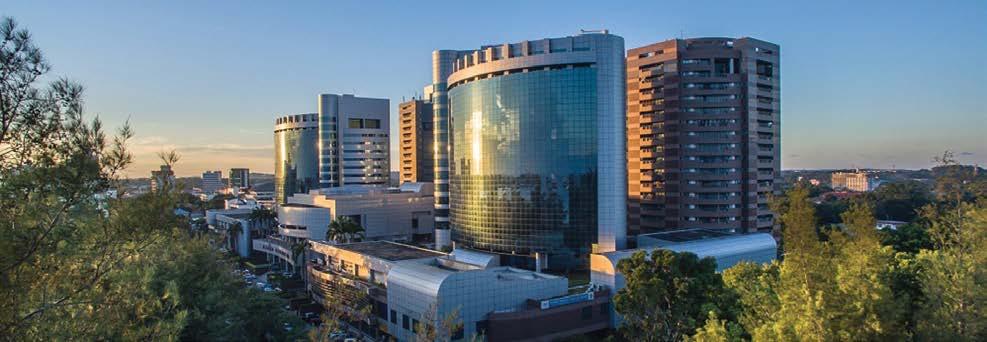
The challenge
Financial Park Labuan is the largest shopping mall on Labuan Island, located near Sabah, Malaysia. The complex features 187 retail shops, two corporate office towers and serviced apartments. It serves as a destination for business, shopping and leisure activities, attracting both locals and tourists alike.
In order to ensure consistent water flow throughout its facility, Financial Park Labuan approached Armstrong Fluid Technology with the specific requirement for a precise water pump system capable of delivering stability with minimal performance fluctuations.
The solution
In 2016, Financial Park Labuan engaged Armstrong Fluid Technology to replace the air-cooled chiller system in the TES tank building with a more efficient, water-cooled system, for the first cluster of serviced apartments. During the same period, Hex pumps were installed to provide extra support in maintaining room temperature stability.
Two years later, an upgrade was called for, and Armstrong implemented two Design Envelope
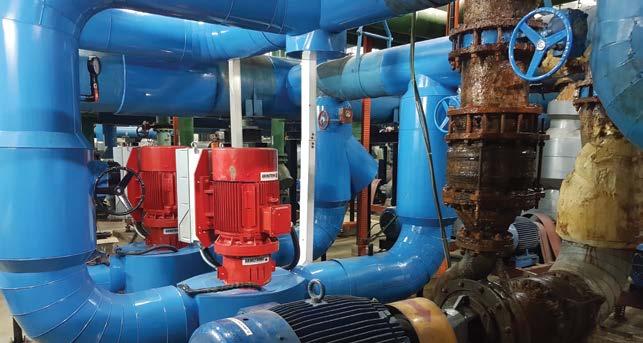
pumps to enhance the water flow in a major circuit that served the event halls and over half of the shopping mall.
In the final phase, Armstrong delivered six more of the latest Design Envelope pumps – the Gen 5 pumps – to complete the circuit support that serves the complex’s office towers.
The result
The precise engineering of Armstrong Fluid Technology’s Design Envelope pumps ensured that water was transported to the pipeline more efficiently.
Compared to the previous infrastructure, where each water pump consumed 2.4 million kWh of energy per month, the installation of Armstrong Fluid Technology’s complete cycle of pumps reduced energy consumption to just 1.6 million kWh per month.
The different phases of improvements allowed Financial Park Labuan to constantly increase its energy savings, achieving up to 38%, by the second phase, and 42%, by the final phase. This change resulted in a total savings of RM 233,000, across the facility, annually.
They also feature fast-charging systems and advanced filtration technology.
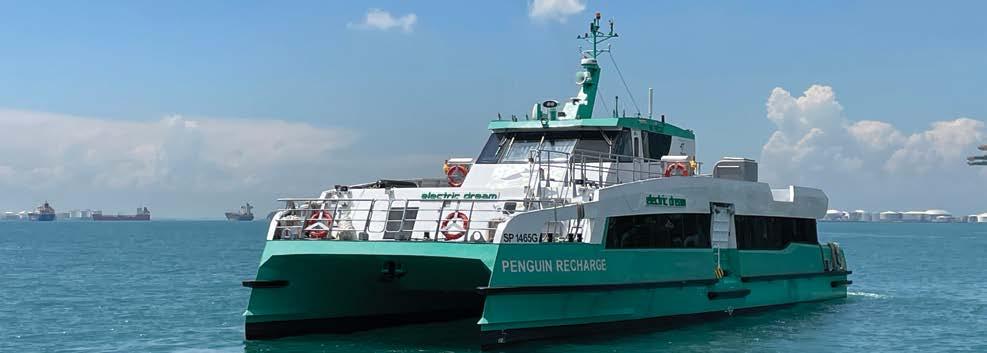
A year ago, Singapore’s homegrown aluminium craft specialist, Penguin International Limited, launched the country’s first, fully electric, commercial ferry service. At present, in its fully operational state, three, fully electric commuter ferries, dubbed the Electric Dream, transport around 3,000 people a day, between the mainland and Pulau Bukom island.
Since January 2024, the three Electric Dream ferries, powered by three rapid DC shore chargers, have together eliminated more than 6,000 tonnes of CO2 emissions. In addition, the Electric Dream also reduces noise pollution and harmful diesel particulates.
The project, spanning more than two years, was the result of a stringent iterative process and a strong collaboration between the project owner Penguin, Danfoss Singapore and other industry partners including Razor Blunt Labs, Incat Crowther UK, and IT solutions partner GEMA Engineering.
Tailored engineering solutions
Unlike conventional electric vehicle charging, Electric Dream’s highvoltage rapid DC shore charger,

installed at the Pulau Bukom Ferry Terminal, is a bespoke solution provided by Danfoss, that enables each electric ferry to cruise at 21 knots across 3 nm (nautical miles) and recharge in 8 minutes or less.
Danfoss developed a specialised Sinus-In-Sinus-Out (SISO) electrical filter that minimises electrical interference during charging, to maintain uninterrupted and stable power delivery even over extended distances. This is pivotal in maintaining system reliability, as electrical noise can disrupt the sophisticated systems on board. Compact, customised filters are installed on the ferries themselves which reduce the weight and size of onboard systems, cutting operational costs while optimising space.
Danfoss variable speed drives,
commonly known as inverters or VFDs, are placed in the main switchboards to allow direct battery connection for maximum utilisation of energy. This higher efficiency has translated into greater cost-effectiveness of the vessel operation.
Razor Blunt Labs’ simulation tool allowed all partners to test and refine their individual components to function cohesively as an integrated unit, from propulsion to charging infrastructure.
GEMA Engineering served as the project’s system integrator and worked closely with Danfoss to programme an intuitive shipboard Ship Control and Monitoring System (SCMS) that could interface seamlessly with the Danfoss DC chargers onshore.
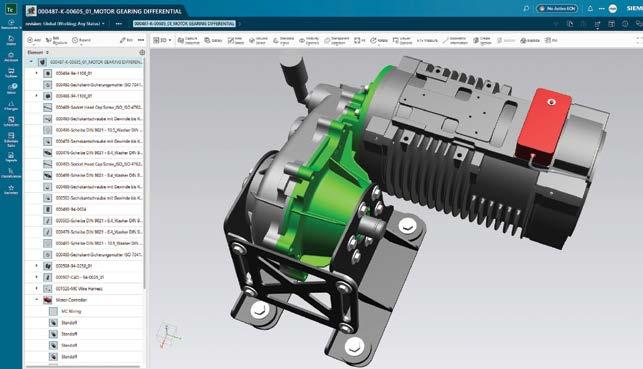
Siemens Digital Industries Software recently announced that it is introducing new versions of its Teamcenter X software so that organisations of all sizes can leverage best-in-class SaaS Product Lifecycle Management (PLM) to digitally transform and drive innovation across the manufacturing industry.
New Teamcenter X offerings introduce prepackaged capabilities out-of-the-box, to include process management and cross domain capabilities that bring together mechanical, electrical and electronics development, and other advanced functionality.
Product availability
Teamcenter X is now available in four offerings:
Teamcenter X Essentials: Designed with ease of deployment and low cost of administration, Teamcenter X Essentials delivers data management for companies focused on mechanical design. It includes CAD data management and product structures with revision management, where used search, check-in/check-out and 3D view and mark-up – while retaining full scalability as an
organisation grows and evolves.
Teamcenter X Standard:
Teamcenter X Standard extends the capabilities of Teamcenter X Essentials, adding additional PLM functionality such as simple change management, project scheduling, document management and report generation – all delivered with out-of-the-box configurations and the ability to be tailored to meet customer needs.
Teamcenter X Advanced:
Teamcenter X Advanced supports companies in need of cross domain collaboration across mechanical, electronic and electrical design, throughout their products’ lifecycle. Teamcenter X Advanced builds on the Standard offering to add data management for electrical and electronic design integration and classification. Teamcenter X Advanced is also delivered with out-of-the-box configurations and the ability to be tailored to meet customer needs.
Teamcenter X Premium: With the full breadth of PLM and the choice of cloud provider, Teamcenter X Premium is built for companies who want to harness
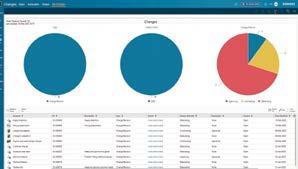
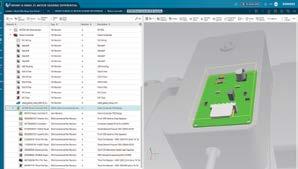
Siemens’ Teamcenter X Advanced brings cross domain lifecycle management across mechanical, electronics and electrical design, and full configurability.
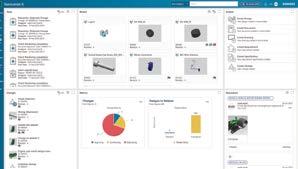
Siemens’ Teamcenter X Premium brings full access to the Teamcenter portfolio, full customisation and configurability and classification capabilities and greater choice of cloud provider.
the full capabilities of Teamcenter in a purpose-built solution to fit their business needs.
It covers the full spectrum of Teamcenter’s capabilities, from enterprise BOM and business system integration, model-based systems engineering (MBSE), manufacturing planning, quality and compliance management, and product cost and service lifecycle management. The Teamcenter X Premium tier also delivers preconfigured solutions tailored for industries such as industrial machinery, medical devices and semiconductors.
Keysight Technologies Inc has introduced the Keysight Artificial Intelligence (KAI) architecture, a portfolio of end-to-end solutions designed to help customers scale artificial intelligence (AI) processing capacity in data centres, by validating AI cluster components using real-world AI workload emulation.
Providing system-level interoperability, performance and efficiency insights, KAI helps operators maximise system performance and pinpoint performance issues not found when testing individual components.
Scaling AI data centres requires testing throughout the design and build process – every chip, cable, interconnect, switch, server and graphics processing unit (GPU) needs to be validated at both the component and system level. Full-stack workload emulation complements physical layer testing, revealing insights not found when testing components alone.
Customers can extract peak AI performance sooner, increasing capacity more quickly and maximising the return on the billions spent on AI clusters.
The KAI architecture enables AI providers, semiconductor fabricators and network equipment manufacturers to:
• Accelerate design: Debug cuttingedge high-speed digital designs, and meet or exceed the latest PCIe, DDR and CXL standards.
• Accelerate development: Verify component-level compliance, including high-speed interconnects, cables and chipsets, and validate workload performance at the system level.
• Accelerate deployment and operations: Validate and tune system-level performance across the entire data centre, reducing the risk of workload failures, by using end-to-end emulation to pinpoint system performance issues before deploying in production.
The Keysight AI architecture, which includes the newly announced KAI Data Centre Builder, features four portfolio suites that, together, address all aspects of AI data centre design, from presilicon simulation through postdeployment system testing and troubleshooting.
• KAI Data Centre Builder: Emulate high-scale AI workloads with measurable fidelity to improve
KAI Data Centre Builder’s workload emulation capability integrates large language model (LLM) and other artificial intelligence (AI) model training workloads into the design and validation of AI infrastructure components – networks, hosts and accelerators. This solution enables tighter synergy between hardware design, protocols, architectures and AI training algorithms.
The KAI Data Centre Builder workload emulation solution
reproduces network communication patterns of real-world AI training jobs to accelerate experimentation, reduce the learning curve necessary for proficiency and provide deeper insights into the cause of performance degradation, which is challenging to achieve through real AI training jobs alone.
The workload emulation application in the KAI Data Centre Builder enables AI operators to:
• Experiment with parallelism parameters, including partition
system performance, predict and mitigate the impact of component failures, and optimise data centre operations.
• KAI Compute: Optimise high-speed digital designs and pioneer next-generation AI chip development with a suite of AIready tools that include electronic design automation, bit-error ratio testers, oscilloscopes and arbitrary waveform generators.
• KAI Interconnect: Validate optical and electrical data paths to ensure scalable, high-speed connectivity up to 1.6 T with a suite of AIready tools, including sampling oscilloscopes, photonic power meters and network interconnect testers.
• KAI Network: Benchmark AI network performance, detect bottlenecks, and optimise AI workload distribution with a suite of AI-ready tools that includes AI workload emulators, distributed network traffic generators and network traffic emulators.
• KAI Power: Optimise power efficiency and energy management across data centre components with a suite of AI-ready tools that include oscilloscopes, power rail probes and electronic design automation.
sizes and their distribution over the available AI infrastructure (scheduling).
• Understand the impact of communications within and among partitions on overall job completion time (JCT).
• Identify low-performing collective operations and drill down to identify bottlenecks.
• Analyse network utilisation, tail latency and congestion, to understand the impact they have on JCT.
Fortinet, a global cybersecurity leader, recently announced FortiAI innovations embedded across the Fortinet Security Fabric platform to enhance protection against new and emerging threats, simplify and automate security and network operations, and secure employee use of AI-enabled services.
FortiAI has now expanded to encompass Fortinet’s entire AIdriven approach across security and network operations, protecting environments and securing AI models and LLMs. Integrated into the Fortinet Security Fabric platform, is the delivery of intelligent, autonomous capabilities to stop advanced threats, streamline operations and support secure AI adoption.
This expansion of FortiAI introduces new capabilities across two key areas – FortiAI-Assist and FortiAI-Protect.
FortiAI-Assist combines GenAI, agentic AI and AIOps to simplify and transform security and network operations with intelligent automation and analytics. New capabilities include:
• Agentic AI applications for network operations
-Autonomous network management initiated through the GenAI assistant enables the creation of network configuration and security policy updates, validation and correction of existing configurations, and troubleshooting and remediation of network issues, without human intervention.
-Automated network optimisation and troubleshooting, using GenAI and AIOps, enhance network operations for wired, wireless and SD-WAN, and proactively identify and offer remediation of issues
before users are impacted.
• Agentic AI applications for security operations
-Automated alert triage prioritises notifications based on risk, context and historical patterns, suppresses duplicate alerts and only flags high-confidence threats within the system or directly to the threat analyst, depending on the organisation’s preferences.
- Adaptive threat hunting scans logs, network traffic and user behaviour, to search for threats, without waiting for human input.
-Root-cause tracing uses AI-driven reasoning to identify an attack’s origin, method and impact.
-Threat intelligence enrichment enhances security intelligence by correlating attack patterns and attributing adversary tactics, improving proactive defence.
FortiAI-Protect enhances security with AI-driven threat detection, enabling the identification of advanced and unknown threats. It also provides contextual risk assessments to strengthen security and enforce access controls for third-party GenAI applications. These enhancements further increase the value of FortiGuard AIpowered Security Services for both new and existing customers. New capabilities include:
• Detecting AI application usage for over 6,500 AI URLs, including GenAI applications. Security teams also gain added context around the use cases, the model used for training, and locating where the data goes..
• Controlling access and content to GenAI using zero-trust principles allows security teams to block shadow AI or high-risk AI application usage. Visibility into AI application lists and additional context, such as geolocation and
training models, also allows admins to define organisation-wide AI usage policies.
• Enhancing threat analysis and malware protection by expanding machine learning and largescale data analysis to detect and neutralise emerging malware threats. Continued refinement of contextual correlation with known threat indicators further reduces false positives, ensuring precise threat identification while maintaining operational efficiency.
• Improving safeguards against sophisticated attacks by continuing to train the intrusion prevention system (IPS) machine learning models to adapt and detect new attack techniques.
INFRASTRUCTURE AND DATA
Organisations can also securely adopt AI with FortiAI-SecureAI by leveraging capabilities that span the Fortinet Security Fabric platform to protect AI infrastructure from networkbased threats, secure web applications and APIs, and defend cloud-native AI workloads across major providers.
FortiAI-SecureAI ensures data integrity, prevents LLM data leakage, safeguards AI models and intellectual property, enforces zero-trust access, and enables early attack detection and response.
FortiAI uses a multi-layered data protection approach to enforce strict privacy controls, preventing data that is shared with the Fortinet GenAI assistant from training the LLM. Queries are also processed locally, ensuring data never leaves the network, while sensitive information is blocked or masked before reaching the language model.
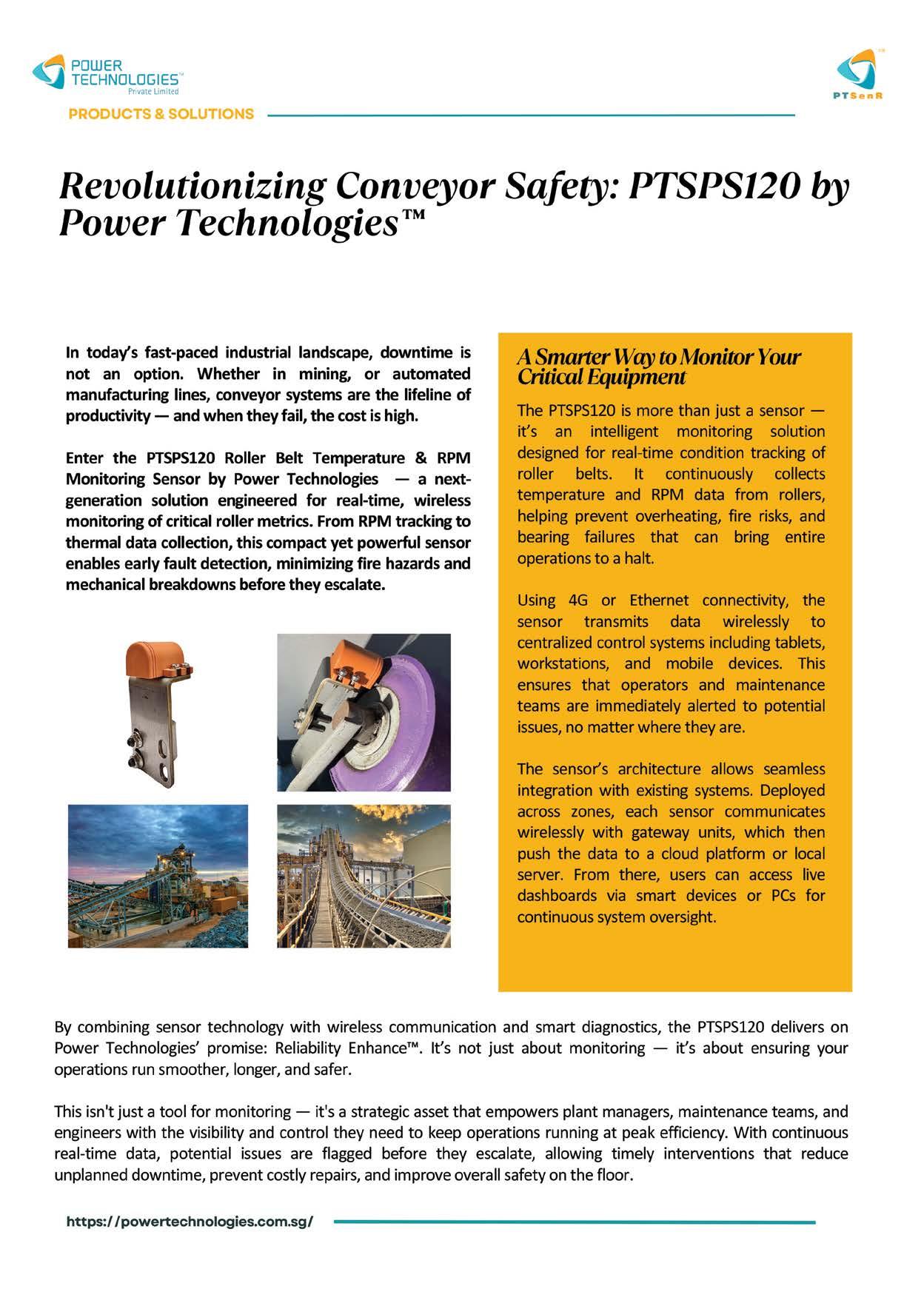
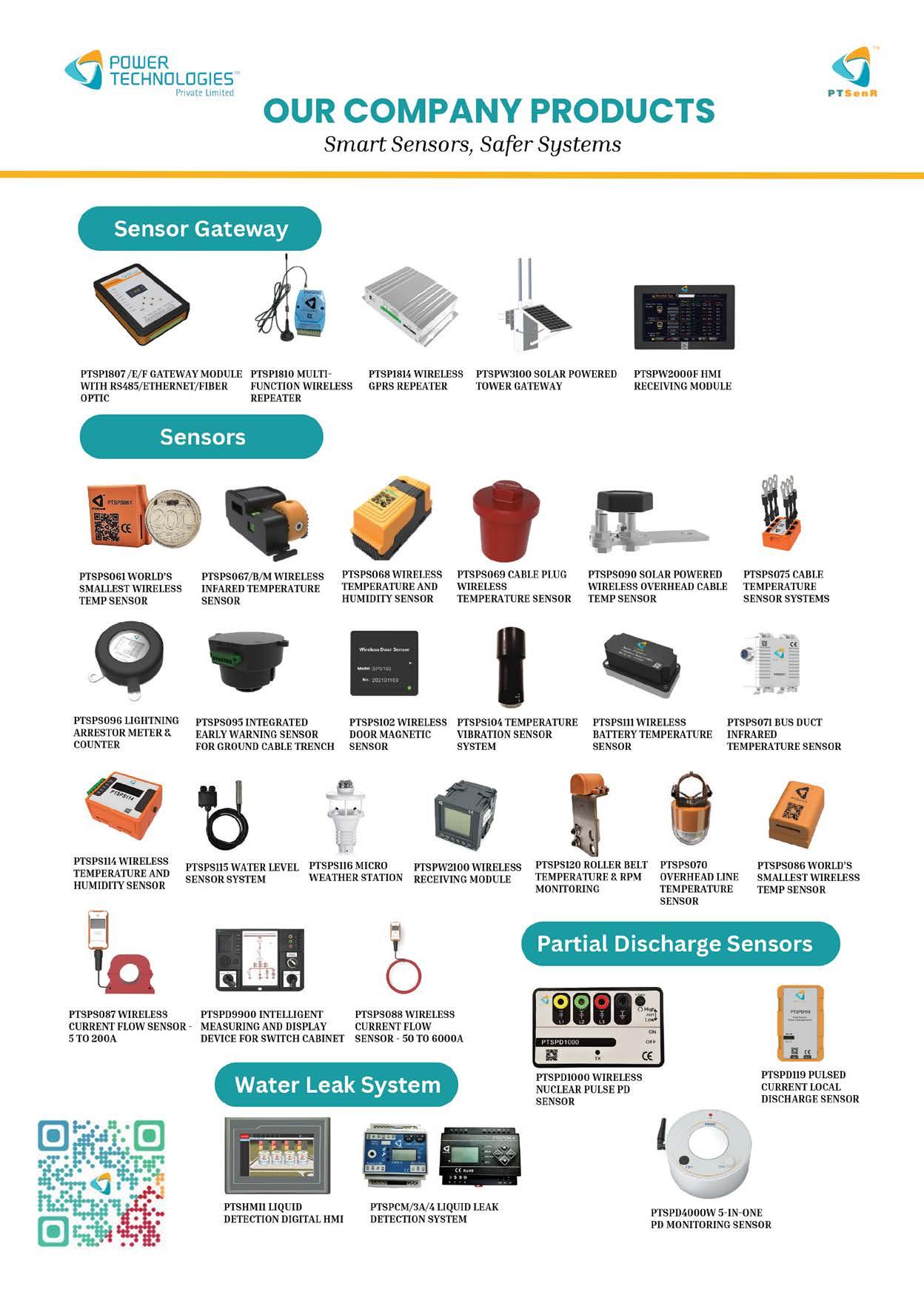
Sequence of events recorders (SERs) or sequence of events (SOE) monitors play a significant role in monitoring and maintaining critical infrastructure, by logging alarms and events in real-time, and in chronological order, to provide visibility to users and help identify the root cause of problems that may occur.
The early SER products would provide 1 millisecond time stamps of the alarm and events they were monitoring, and the results would have been printed via an inbuilt printer so that the alarm or events list could be printed on paper for analysis.
The logging of alarms and events has since progressed with SOE monitoring being done to sub 1 millisecond time stamps and the results being logged to a local or remote SCADA or distributed control system (DCS). These systems are applicable to all critical infrastructure industries including oil & gas, nuclear, energy and utilities, manufacturing, data centres and healthcare.
All of these critical industries
could have situations where one alarm or event could trigger a series or avalanche of others, extremely quickly, afterwards.
Technology can be adopted to enable users to quickly identify the possible cause of the problem which would usually be the first alarm and not the subsequent ones, helping to diagnose any issues in a timely manner.
Omniflex has been a world leader is supplying SER and SOE systems and the Maxiflex 32SOE Digital Input Module provides a time stamp within 200 microseconds of the alarm event happening, which is far quicker than the older SER systems.
This allows for much better accuracy in locating the first alarm, if multiple alarm events occur in quick succession.
The Maxiflex 32SOE is an intelligent module equipped with a spike filter to prevent noise from generating false alarm events on the input, and a debounce filter for inputs that have contact bounce problems. Using multiple 32SOE modules can allow SOE systems
Hottinger Brüel & Kjær (HBK), a global leader in test and measurement solutions, has announced the launch of digiBOX, a next-generation, multi-channel edge-amplifier, tailored to meet the demands of industrial process control and weighing applications. With the advent of Industry 4.0, the need for measurement solutions that can process complex data streams in real time, while ensuring precision, reliability and connectivity, has never been greater.
HBK’s Edge Amplifier, digiBOX combines precision, advanced connectivity, industrial-grade durability and modular flexibility,
for optimising industrial and weighing processes.
The digiBOX allows for close-proximity placement to sensors and offers real-time processing of measurement data. Its seamless IT/OT integration enables advanced interoperability between information technology and operational technology systems.
The edge-amplifier’s modular design is available in 2- or 4-channel configurations, supporting a wide range of sensors (strain gauges, load cells and piezoelectric sensors). Its user-friendly interface provides intuitive setup, monitoring and remote management.
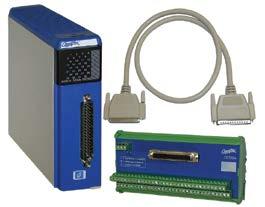
The Maxiflex 32SOE Digital Input Module, from Omniflex, provides a time stamp within 200 microseconds of the alarm event happening.
to be constructed with up to 480 time-stamped inputs per node, with no limit on the number of nodes, providing large distributed systems.
The multiple nodes can all be GPS time synchronised for the larger distributed systems like the ones Omniflex has provided on offshore gas platforms in the North Sea, where over 3,500 distributed alarms and events associated with the generators and compressors were all individually monitored in the local SCADA system and all time-stamped to 200 microseconds resolution.
digiBOX’s hardware has IP67-rated housing, in order to withstand harsh conditions such as dust, moisture and vibrations. The flexible and robust amplifier is available in two domain-specific firmware choices – digiBOX Industrial and digiBOX Weighing. digiBOX Industrial has been engineered to handle the requirements of modern industrial production such as press-load monitoring, joiningprocesses and assembly lines. digiBOX Weighing has been specifically designed to meet the critical demands of weighing applications, offering accuracy, seamless integration and robust performance.
XP Power has introduced the CCR range of compact, low-profile (25.4 mm) AC-DC power supplies with flexible cooling options and power ratings from 110 W to 420 W, allowing more efficient use of space within the end equipment.
Approved for use in medical and industrial applications, the highefficiency and high-power density units feature a baseplate-cooled design that ensures effective thermal management and quiet operation for noise-sensitive applications, even in sealed enclosure environments. These features lead to power supplies with longer lifespans, that require less maintenance and service, which can significantly reduce the total cost of ownership (TCO).
The CCR range is compliant, for medical applications, to IEC606011 Ed. 4 with primary to secondary isolation at 4000 VAC (2 x MOPPs) and 1 x MOOP from primary to earth (1800 VAC) and secondary to earth (1500 VAC).
Combined with low earth (<300 µA) and patient (<75 µA) leakage currents, the CCR range is ideal for easy integration into body-floating (BF)-rated medical devices, for respiratory care, imaging, patient monitoring and patient treatment. Industrial applications include process control, test & measurement and industrial printing.
The CCR range accepts a wide input voltage range of 85 VAC to 264 VAC for global use and covers the common single rail outputs from 12 VDC to 54 VDC. Depending on the chosen cooling option – convection, conduction or forced air – power ratings are CCR200 (110 W / 170 W / 200 W), CCR300 (160 W / 250 W / 300 W), and CCR420 (280 W / 350 W / 420 W), respectively.
All models have overvoltage protection, overload protection and short circuit protection with trip and restart as standard, as well
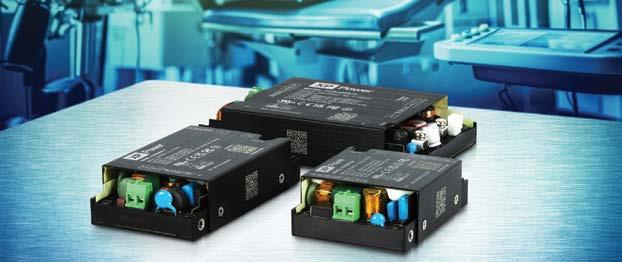
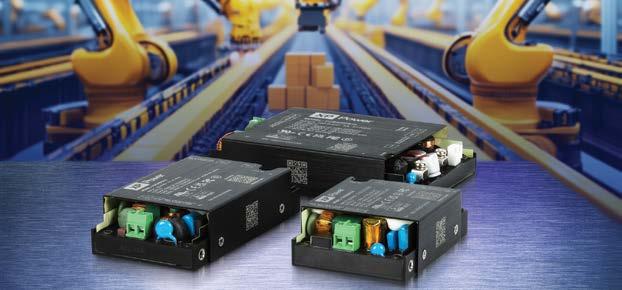
as over-temperature protection with auto reset. Featuring Class B conducted and radiated emissions, the CCR range eliminates the need for external filtering. The units offer high efficiencies of up to 94%, minimising waste heat, and can operate in ambient temperatures from -40 °C to up to +80 °C with appropriate derating above +50 °C.
The CCR200, CCR300, and CCR420 series are available from Digi-Key, element14, Mouser, RS Components, approved regional distributors or direct from XP Power, and come with a three-year warranty.
XP Power is a leading provider of power solutions, including AC-DC power supplies, DC-DC converters, high voltage power supplies and RF power supplies. With ISO9001:2015 certification, XP Power offers total quality, from in-house
design through to manufacturing facilities around the world. The company offers a wide range of power products available from one source and technical and customer support, aiding both vendor consolidation and cost reduction programmes.
A London Stock Exchange listed public company, XP Power Ltd has design centres in North America (Massachusetts, New Jersey and California), Germany and Singapore (which also serves as the company’s headquarters).
Manufacturing facilities are located in North America, Vietnam, China and Germany. The design teams push back the boundaries of cost and technology, providing market leading power solution products. Local application teams provide expert technical support to help customers integrate and use XP Power products worldwide.
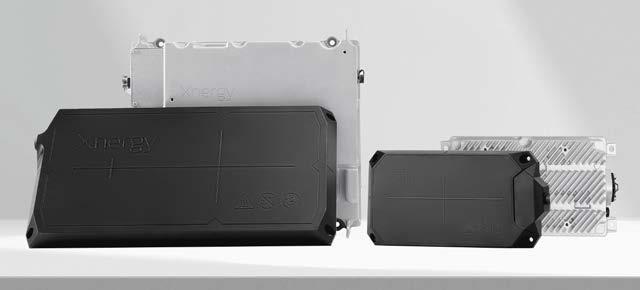
Xnergy Autonomous Power Technologies (Xnergy), a leading provider of high-power wireless charging solutions for autonomous electrified mobility, has developed the Phoenix – a compact high-power contactless charger dedicated for smaller applications such as delivery and service robots, smaller AMRs and AGVs. With its high-power density, Phoenix offers global mobile robot and mobility OEMs the benefits of wireless charging through a smaller form factor and carbon footprint.
Phoenix delivers 1,500 watts of power and accommodates wide tolerances of up to 5 cm of airgap, in a size slightly bigger than a mobile phone such as the iPhone 16 Pro Max.
To achieve higher efficiency and reduce heat generation, Xnergy selected Infineon’s MOFSETs, current sensors, and gate drivers for the wireless charger. The
universal wireless charging supports multiple battery types. Phoenix has received positive feedback from clients during sample testing.
Mr Nik Faisal, General Manager of DF Robotics Sdn Bhd, Malaysia, said, “The compact size of the Phoenix wireless charger makes an excellent fit for our latest AMR model. Its seamless integration and consistent performance in fast and reliable charging have fully met our requirements.”
“Our collaboration with Infineon underscores our commitment to innovation and excellence in wireless charging solutions. The Phoenix is a testament to how strategic partnerships can address the growing demand for efficient, compact and sustainable power solutions across autonomous mobility sectors,” said Dr C F Tong, Founder and CEO of Xnergy.
“By combining Infineon’s advanced components with our
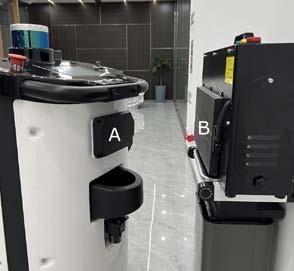
proprietary technology, we are setting new standards in the high density wireless charger – small in size, fast in charging. We want to make autonomous charging seamless and easy to adopt,” he added.
Xnergy
Through its deployment-ready, proprietary technology, Xnergy overcomes the limitations of traditional charging and enables a new way of power transfer – from electric vehicles to autonomous industrial robots. To-date, thousands of modules have been deployed, effectively powering electrified mobility in nearly 40 countries.
The company is also setting the industry standard for wireless charging, by building an ecosystem of end-users, regulators and manufacturers, to establish the strong foundation required for widespread adoption.
